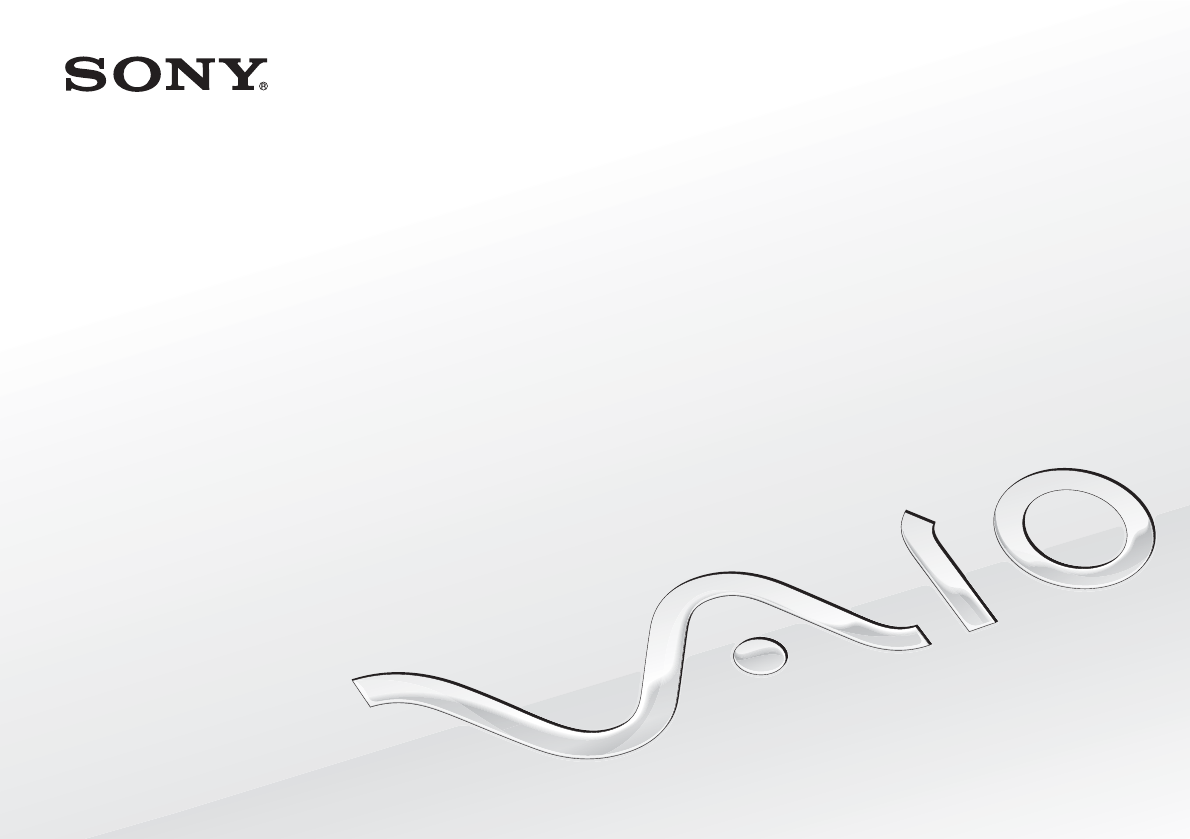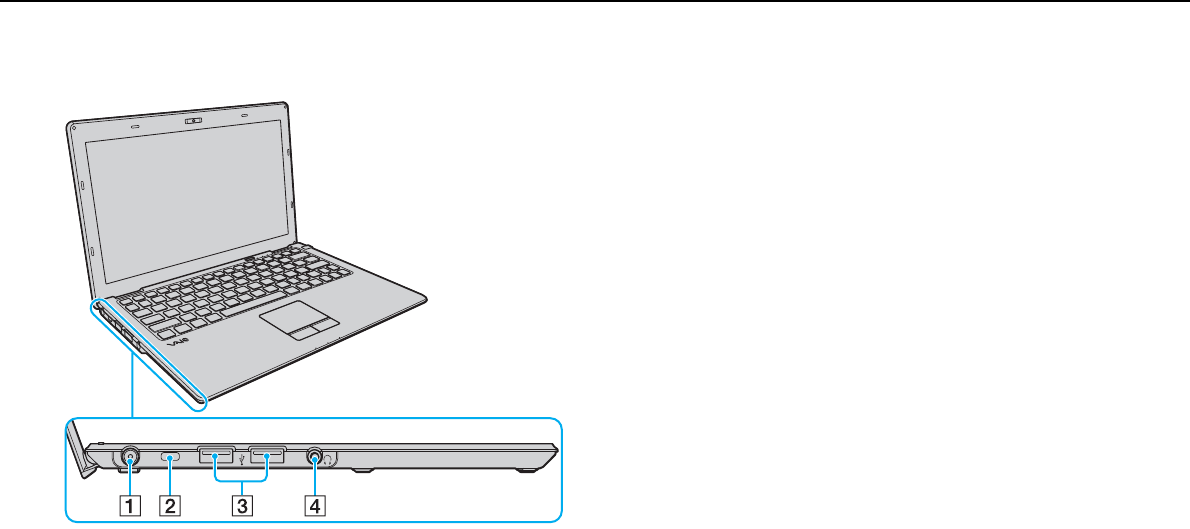Sony Group PCG21112L Notebook PC User Manual 4860 UG
Sony Corporation Notebook PC 4860 UG
Contents
- 1. User Manual Safety Guide
- 2. User Manual
User Manual

3
nN
Contents
Before Use.......................................................................... 5
Finding More about Your VAIO Computer .................... 6
Ergonomic Considerations .......................................... 12
Getting Started.................................................................. 15
Locating Controls and Ports........................................ 15
About the Indicator Lights ........................................... 22
Connecting a Power Source ....................................... 23
Using the Battery Pack................................................ 24
Shutting Down Your Computer Safely ........................ 30
Using the Power Saving Modes .................................. 30
Updating Your Computer ............................................ 32
Using Your VAIO Computer.............................................. 33
Using the Keyboard..................................................... 33
Using the Touch Pad................................................... 35
Using the Built-in Camera ........................................... 37
Using "Memory Stick".................................................. 38
Using Other Modules / Memory Cards........................ 43
Using the Internet........................................................ 46
Using the Network (LAN) ............................................ 48
Using the Wireless LAN .............................................. 49
Using the Wireless WAN............................................. 56
Using the Bluetooth Function ...................................... 60
Using the GPS Function ..............................................65
Using Peripheral Devices..................................................67
Connecting an Optical Disc Drive................................67
Connecting External Speakers or Headphones ..........69
Connecting an External Display ..................................70
Selecting Display Modes .............................................72
Using the Multiple Monitors Function ..........................73
Connecting a USB Device ...........................................74
Customizing Your VAIO Computer....................................76
Setting the Password...................................................76
Using Intel VT ..............................................................82
Using the VAIO Control Center ...................................83
Using the VAIO Power Management...........................84
Precautions .......................................................................86
Safety Information .......................................................86
Care and Maintenance Information .............................90
Handling Your Computer .............................................91
Handling the LCD Screen............................................93
Using the Power Source..............................................94
Handling the Built-in Camera.......................................95
Handling Discs.............................................................95
Using the Battery Pack ................................................96

4
nN
Handling "Memory Stick"............................................. 97
Handling the Built-in Storage Device .......................... 97
Troubleshooting ................................................................ 99
Computer .................................................................. 100
System Security ........................................................ 109
Battery....................................................................... 110
Built-in Camera ......................................................... 111
Networking ................................................................ 113
Bluetooth Technology ............................................... 117
GPS........................................................................... 121
Display ...................................................................... 122
Printing ...................................................................... 125
Speakers ................................................................... 125
Touch Pad................................................................. 127
Keyboard................................................................... 128
Floppy Disks.............................................................. 128
Audio/Video............................................................... 129
Memory Cards........................................................... 131
Peripherals ................................................................ 132
Trademarks..................................................................... 134
Notice.............................................................................. 140

5
nN
Before Use >
Before Use
Congratulations on your purchase of this Sony VAIO® computer, and welcome to the on-screen User Guide. Sony has
combined leading-edge technology in audio, video, computing, and communications to provide a state-of-the-art personal
computing experience.
!
External views illustrated in this manual may look slightly different from those of your computer.
How to find specifications
Some features, options, and supplied items may not be available on your computer.
US model_BGN
To find out about the configuration of your computer, visit the Sony online support web site at the following URLs:
❑For customers in USA
http://esupport.sony.com/EN/VAIO/
❑For customers in Canada
http://www.sony.ca/support/
❑For customers in Spanish-speaking Latin American countries or areas
http://esupport.sony.com/LA/
❑For customers in Brazil
http://esupport.sony.com/BR/
US model_END
Euro model_BGN
To find out about the configuration of your computer, visit the VAIO Link web site at http://www.vaio-link.com.

6
nN
Before Use >
Finding More about Your VAIO Computer
Euro model_END
Except US model_BGN
Except Euro_BGN
To find out about the configuration of your computer, see the Specifications (supplied with your computer).
Except Euro_END
Except US model_END
Finding More about Your VAIO Computer
This section provides support information about your VAIO computer.
1. Printed Documentation
US model_BGN
❑Quick Start Guide — An overview of components connection, set-up information, etc.
❑Safety Information — Safety guidelines and owner information.
US model_END
Euro model_BGN
❑Quick Start Guide — An overview of components connection, set-up information, etc.
❑Troubleshooting and Recovery Guide
❑Regulations, Guarantee, and Service Support
Euro model_END
Except US model_BGN
Except Euro_BGN
❑Quick Start Guide — An overview of components connection, set-up information, etc.
❑Specifications — The hardware configurations of your VAIO computer.

7
nN
Before Use >
Finding More about Your VAIO Computer
❑Troubleshooting and Recovery Guide
❑Safety Regulations
China model_BGN
❑Warranty Card
❑Approval sheet, etc.
China model_END
Except Euro_END
Except US model_END
2. On-screen Documentation
US model_BGN
❑Help and Support — General information and technical assistance for your VAIO computer.
To access Help and Support:
1Click Start and Help and Support.
2Choose from the following categories to find the answers you need.
Get started with my VAIO Get help with Internet and wireless setup, security setup, personalizing your VAIO computer, and creating
recovery discs and more.
Use my VAIO Access interactive help in the form of VAIO tutorials, how-to articles, the VAIO technology page,
specifications, and system and software information.
You can find useful documentation such as below:
- VAIO User Guide (This manual)
- VAIO Recovery Center User Guide - Information about restoring individual software programs,
hardware drivers, and drive partition(s) or your entire built-in storage device to the original factory settings
- Software Information
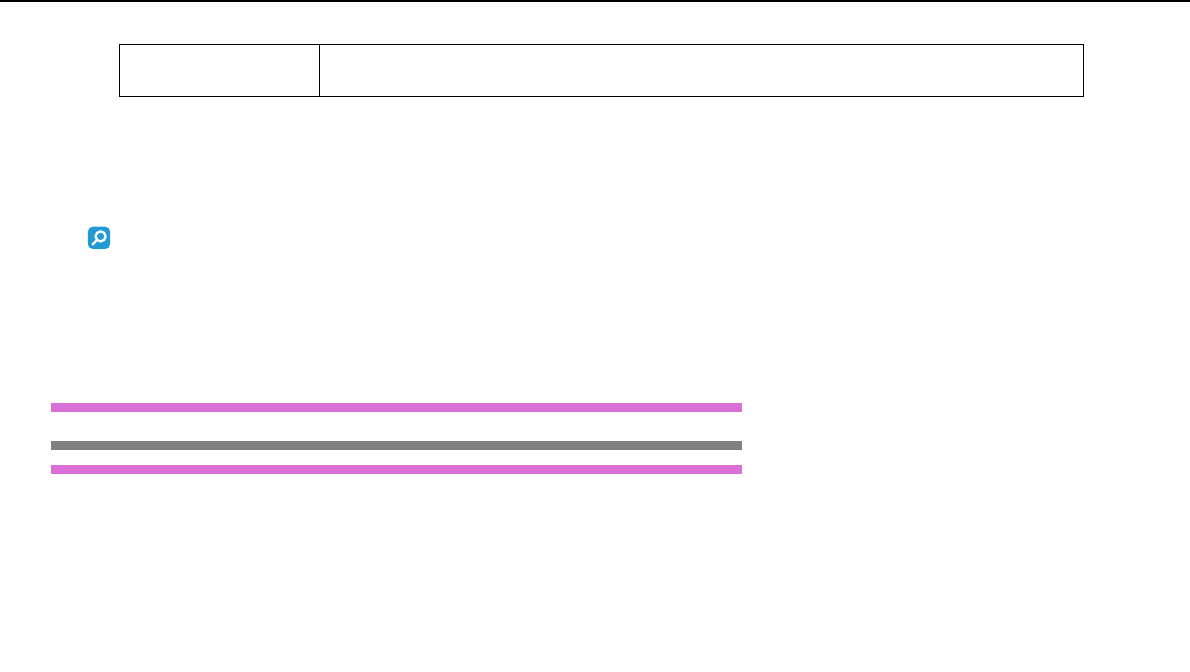
8
nN
Before Use >
Finding More about Your VAIO Computer
❑Program help files — May be included with the preinstalled software programs on your computer. You may be able to
access the help files from the help menu on a specific program.
❑SmartWi™ Connection Utility Help — Information about setting up Bluetooth®, wireless LAN, GPS, and wireless WAN
functions.
Features and options may not be available on your computer.
See the specifications to find out about configuration of your computer.
To access this on-screen guide:
1Click Start, All Programs, and SmartWi Connection Utility.
2Click SmartWi Connection Utility Help.
US model_END
Euro model_BGN
Except US model_BGN
❑User Guide (This manual) — Features of your computer and information about solving common problems.
To view this on-screen guide:
1Click Start, All Programs, and VAIO Documentation.
2Open the folder for your language.
3Select the guide you want to read.
✍
You can manually browse to the user guides by going to Computer > VAIO (C:) (your C drive) > Documentation > Documentation and opening the
folder for your language.
Troubleshoot my VAIO Maintain and troubleshoot your VAIO computer with VAIO Care, system restore, backup and recovery, and
contact Sony support.

9
nN
Before Use >
Finding More about Your VAIO Computer
Euro model_END
Except Euro_BGN
❑VAIO Manual — General information and technical assistance for your VAIO computer.
To access VAIO Manual, double-click VAIO Manual on the desktop.
Except Euro_END
❑Windows Help and Support — A comprehensive resource for practical advice, tutorials, and demonstrations to help you
learn to use your computer.
To access Windows Help and Support, click Start and Help and Support, or press and hold the Microsoft Windows
key and press the F1 key.
Except US model_END
3. Support Web Sites
US model_BGN
❑Sony online support web site
The Sony online support web site provides instant access to information on commonly encountered problems. Type a
description of the problem and the Knowledge Database searches for the corresponding solutions online.
❑For customers in USA
http://esupport.sony.com/EN/VAIO/
❑For customers in Canada
http://www.sony.ca/support/
❑For customers in Spanish-speaking Latin American countries or areas
http://esupport.sony.com/LA/

10
nN
Before Use >
Finding More about Your VAIO Computer
❑For customers in Brazil
http://esupport.sony.com/BR/
❑Operating system online support web site
Your computer comes preinstalled with a Microsoft Windows operating system. For operating system support, you can
visit Microsoft customer support at http://support.microsoft.com/directory/.
US model_END
Euro model_BGN
If you have any problem with the computer, you can visit the VAIO-Link web site at http://www.vaio-link.com for
troubleshooting.
Before contacting VAIO-Link by telephone, try to solve the problem by reading the supplied documentation and visiting other
Sony web sites.
❑For more about VAIO and becoming part of the growing VAIO community, visit the web site at http://www.club-vaio.com.
❑For online purchases, visit the web site at http://www.sonystyle-europe.com.
❑For other Sony products, visit the web site at http://www.sony.net.
When you contact VAIO-Link by telephone, have the serial number of your VAIO computer ready at hand. The serial number
is located on the bottom, the back panel, or inside the battery compartment of your VAIO computer.
Euro model_END
GVD model_BGN
If you have any problem with the computer, you can visit the following VAIO online web sites for troubleshooting:
❑http://www.sony-asia.com/support/vaio/ (English)
❑http://scs.sony.co.kr/ (Korean)
❑http://service.sony.com.tw/ (Traditional Chinese)

11
nN
Before Use >
Finding More about Your VAIO Computer
Before contacting VAIO Helpdesk by telephone, try to solve the problem by reading the supplied documentation and visiting
other Sony web sites.
❑For other Sony products, visit the web site at http://www.sony.net.
❑For available optional accessories, visit the following web sites:
❑http://vaio-online.sony.com/ (English)
❑http://vaio-online.sony.co.kr/ (Korean)
❑http://www.sonystyle.com.tw/vaio/ (Traditional Chinese)
GVD model_END
China model_BGN
If you have any problem with the computer, you can visit the VAIO online web sites at http://service.sony.com.cn/vaio/ for
troubleshooting.
Before contacting VAIO Helpdesk by telephone, try to solve the problem by reading the supplied documentation and visiting
other Sony web sites.
❑For other Sony products, visit the web site at http://www.sony.net.
❑For available optional accessories, visit the web site at http://vaio-online.sony.com/cn/.
China model_END
US model_BGN
4. Customer Information Center
If you do not find the information you are looking for at our site, you may call Sony directly. You can find the contact numbers
on the Sony online support web site. In order to receive the fastest and most efficient services, have the following information
readily available:
1Your VAIO computer model

12
nN
Before Use >
Ergonomic Considerations
You can find it at the lower right corner of the display on the computer.
2Your computer's serial number
You can find it on the bottom, the back panel, or inside the battery compartment of your Sony VAIO computer. The serial
number is the last 7 digits of the number below the barcode.
3The operating system on your computer
4The hardware component or the software program that is causing the problem
5A brief description of the problem
5. In Store Service & Support (available in USA only)
Make an appointment with a Sony certified technician at a U.S. Sony Style store and get personalized service and support
for your VAIO PC. Sony Style Backstage Technicians can assist with the setup of your new VAIO PC, system optimization,
data rescue, and any repair service you might need.
Visit the web site at www.sonystyle.com/backstage to find the nearest location.
US model_END
Ergonomic Considerations
You will be using your computer as a portable device in a variety of environments. Whenever possible, you should attempt
to take account of the following ergonomic considerations for both stationary and portable environments:
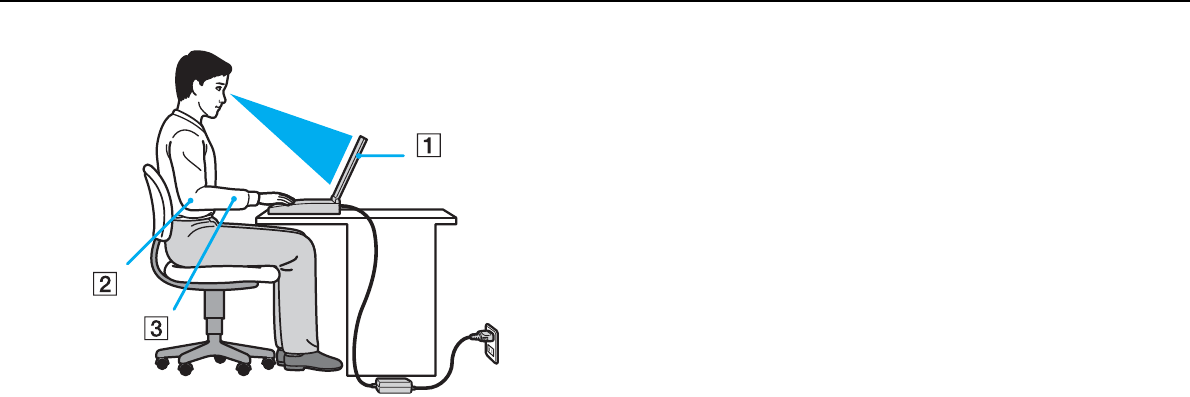
13
nN
Before Use >
Ergonomic Considerations
❑Position of your computer – Place the computer directly in front of you (1). Keep your forearms horizontal (2), with your
wrists in a neutral, comfortable position (3) while using the keyboard or the pointing device. Let your upper arms hang
naturally at your sides. Take frequent breaks while using your computer. Excessive use of the computer may strain eyes,
muscles, or tendons.
❑Furniture and posture – Sit in a chair with good back support. Adjust the level of the chair so your feet are flat on the
floor. A footrest may make you more comfortable. Sit in a relaxed, upright posture and avoid slouching forward or leaning
far backwards.
❑Viewing angle of the computer's display – Use the display's tilting feature to find the best position. You can reduce eye
strain and muscle fatigue by adjusting the tilt of the display to the proper position. Adjust the brightness level of the display
as well.
❑Lighting – Choose a location where windows and lights do not cause glare and reflection on the display. Use indirect
lighting to avoid bright spots on the display. Proper lighting adds to your comfort and work efficiency.

15
nN
Getting Started >
Locating Controls and Ports
Getting Started
This section describes how to get started using your VAIO computer.
US model_BGN
!
Before starting your computer for the first time, do not connect any other hardware that did not originally come with your computer. Upon completion,
connect one device (for example, a printer, an external hard disk drive, a scanner, and so on) at a time, following the manufacturer's instructions.
US model_END
❑Locating Controls and Ports (page 15)
❑About the Indicator Lights (page 22)
❑Connecting a Power Source (page 23)
❑Using the Battery Pack (page 24)
❑Shutting Down Your Computer Safely (page 30)
❑Using the Power Saving Modes (page 30)
❑Updating Your Computer (page 32)
Locating Controls and Ports
Take a moment to identify the controls and ports shown on the following pages.
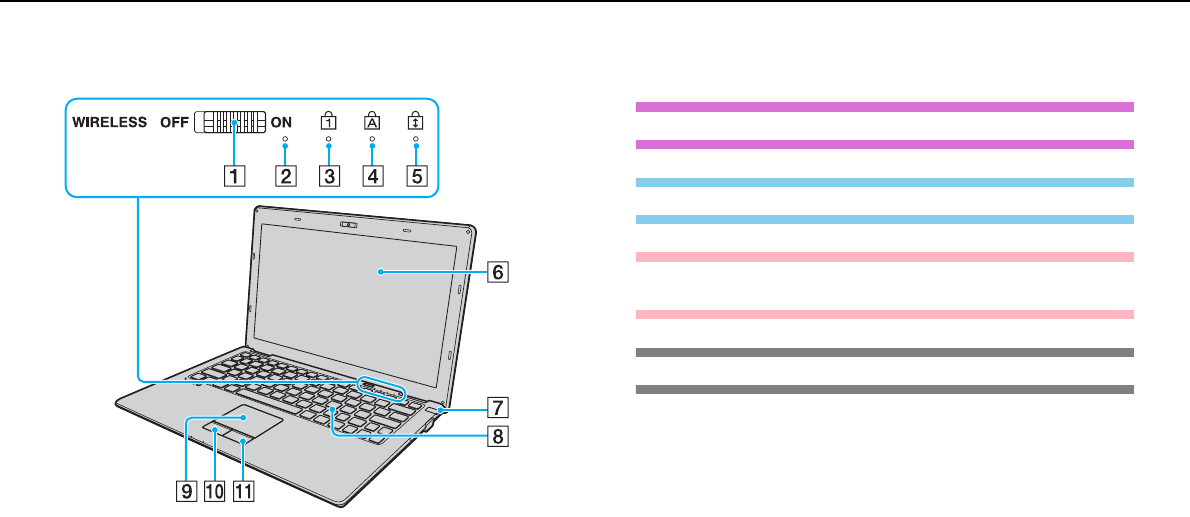
16
nN
Getting Started >
Locating Controls and Ports
Front
US model_BGN
AWIRELESS switch (page 49), (page 60)
US model_END
GVD model_BGN
AWIRELESS switch (page 49), (page 56), (page 60)
GVD model_END
China model_BGN
AWIRELESS switch (page 49), (page 56), (page 60)
ON means "ON," and OFF means "OFF."
China model_END
Euro model_BGN
AWIRELESS switch (page 49), (page 56), (page 60), (page 65)
Euro model_END
BBuilt-in microphone (monaural)
CNum lock indicator (page 22)
DCaps lock indicator (page 22)
EScroll lock indicator (page 22)
FLCD screen (page 93)
GPower button/Power indicator (page 22)
HKeyboard (page 33)
ITouch pad (page 35)
JLeft button (page 35)
KRight button (page 35)
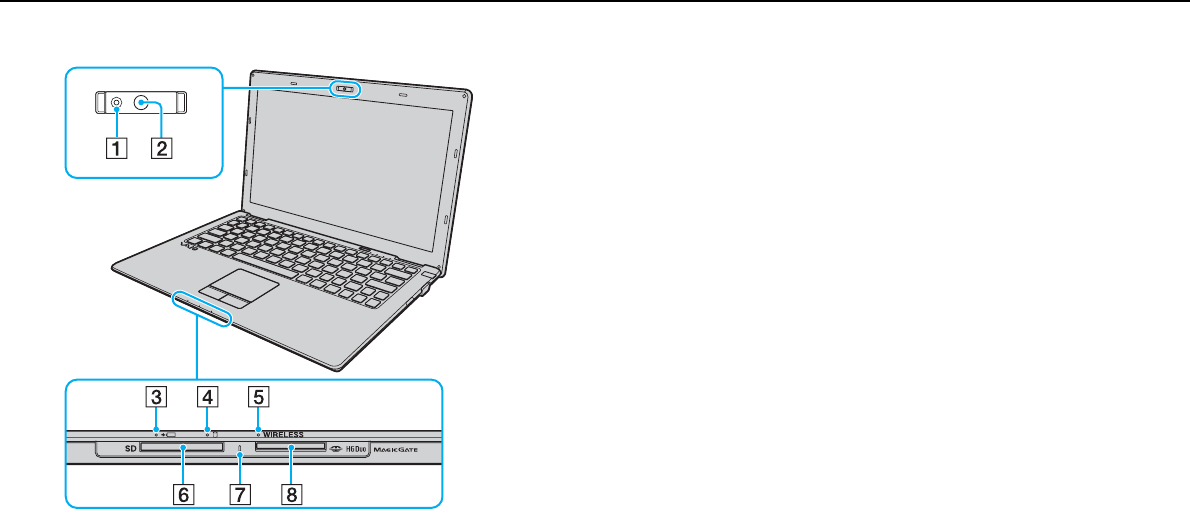
17
nN
Getting Started >
Locating Controls and Ports
ABuilt-in MOTION EYE camera indicator (page 22)
BBuilt-in MOTION EYE camera (page 37)
CCharge indicator (page 22)
DDisc drive indicator (page 22)
EWIRELESS indicator (page 22)
FSD memory card slot (page 43)
GMedia Access indicator (page 22)
H"Memory Stick Duo" slot* (page 38)
* Your computer supports only Duo-size "Memory Stick".
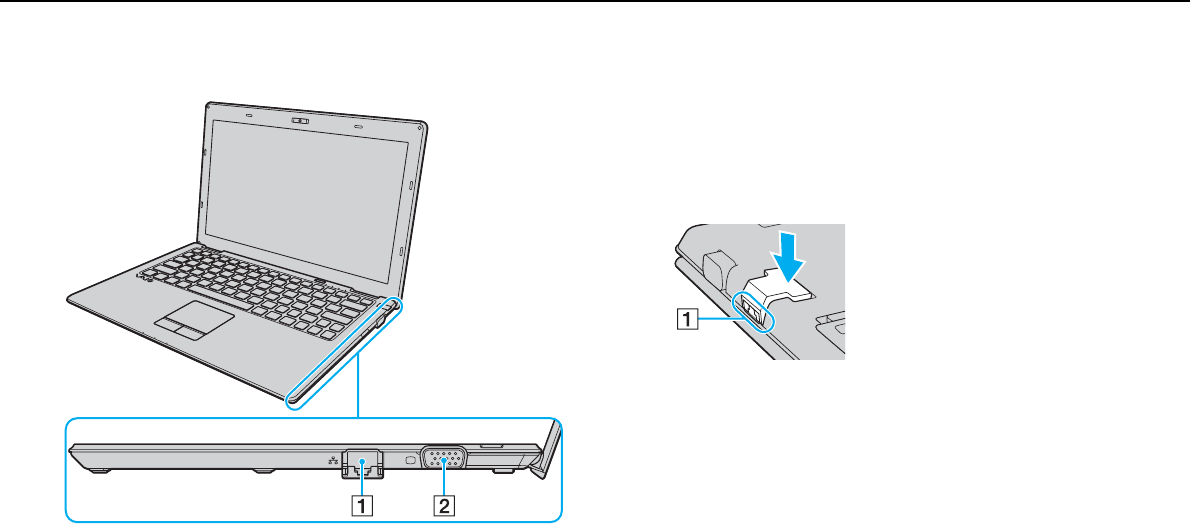
19
nN
Getting Started >
Locating Controls and Ports
Right
ANetwork (LAN) port (page 48)
Pull the port cover down before using the network (LAN) port.
The port cover may disengage if you exert pressure on it when
opening it or disconnecting a LAN cable. To attach the port
cover, align the cover with the edge (1) of the port and push the
cover down until it clicks into place.
BMonitor port (page 70)
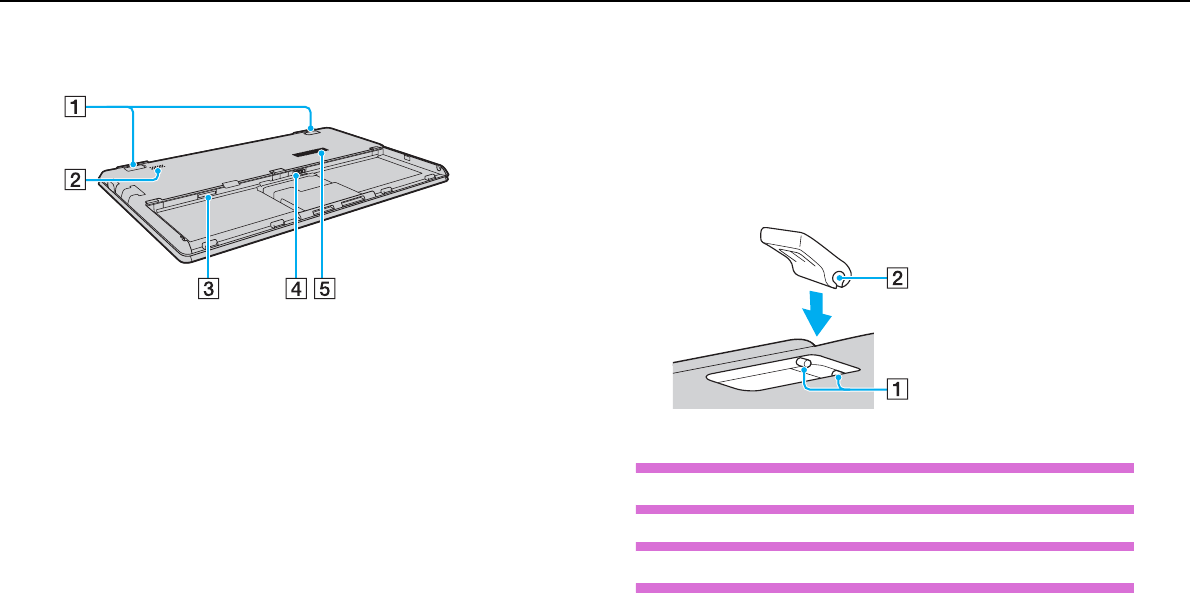
21
nN
Getting Started >
Locating Controls and Ports
Bottom
ATilt feet
Unfold the tilt feet to adjust the angle of your computer before
using the network (LAN) port and the monitor port.
The tilt feet may disengage if you exert pressure on it when
unfolding it. To attach the tilt feet, push it down while aligning the
projections (1) with the snap-fit joint (2) until it snaps into place.
BBuilt-in speaker (monaural)
Except US model_BGN
CSIM card slot* (page 56)
Except US model_END
US model_BGN
DSIM card slot*
US model_END
EBattery connector (page 24)
FAir vent
* On selected models only.
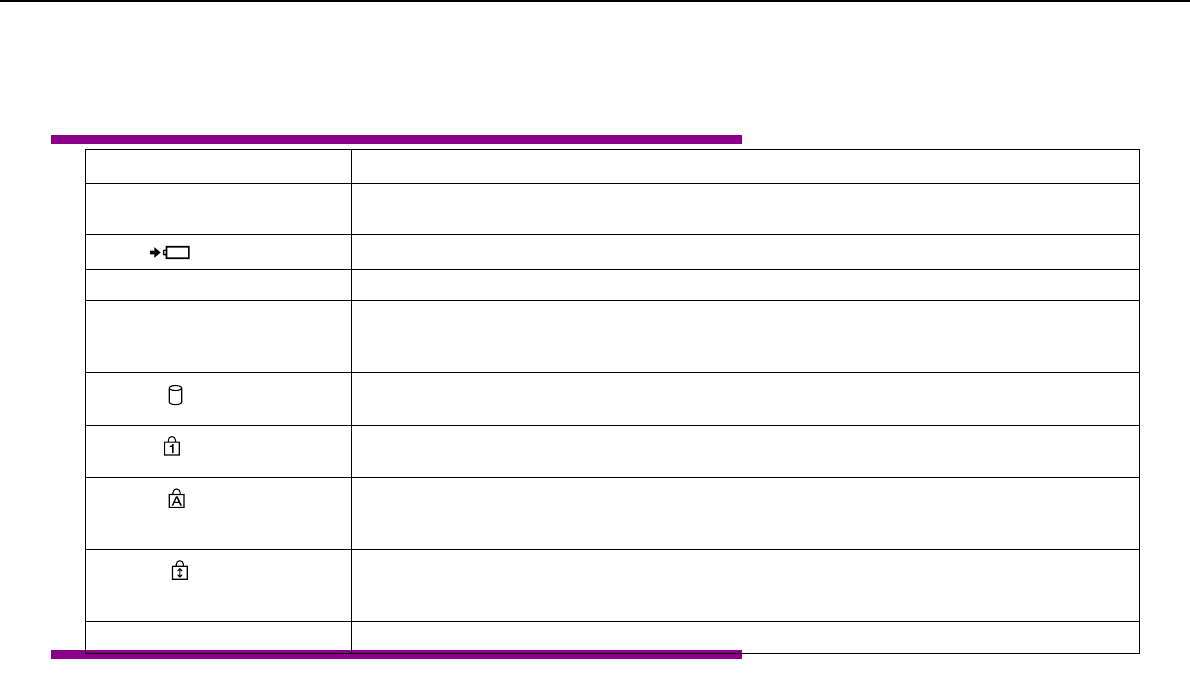
22
nN
Getting Started >
About the Indicator Lights
About the Indicator Lights
Your computer is equipped with the following indicator lights:
IRX-4860_BGN
IRX-4860_END
Indicator Functions
Power 1Illuminates in green while the computer is on, blinks slowly in orange while the computer is in Sleep mode, and
goes out when the computer is turned off or enters Hibernate mode.
Charge Illuminates while the battery pack is charging. See Charging the Battery Pack (page 28) for more information.
Built-in MOTION EYE camera Illuminates while the built-in camera is in use.
Media Access Illuminates while data access to a memory card, such as "Memory Stick" and an SD memory card, is in
progress. (Do not place the computer into Sleep mode or turn it off while this indicator light is lit.) When the
indicator light is unlit, the memory card is not in use.
Disc drive Illuminates while data access to the built-in storage device or the optical disc drive is in progress. Do not place
the computer into Sleep mode or turn it off while this indicator light is lit.
Num lock Press the Num Lk key to activate the numeric keypad. Press it a second time to deactivate the numeric keypad.
The numeric keypad is not active when the indicator light is unlit.
Caps lock Press the Caps Lock key to type letters in uppercase. Letters appear in lowercase if you press the Shift key
while the indicator light is lit. Press the key a second time to turn off the indicator light. Normal typing resumes
when the Caps lock indicator light is turned off.
Scroll lock Press the Fn+Scr Lk keys to change how you scroll the display. Normal scrolling resumes when the Scroll lock
indicator light is turned off. The Scr Lk key functions differently depending on the program you are using and
does not work with all programs.
WIRELESS Illuminates while one or more wireless options are enabled.

23
nN
Getting Started >
Connecting a Power Source
Connecting a Power Source
Except IRX-4860_BGN
You can use either an AC adapter or a rechargeable battery pack for supplying power to your computer.
Except IRX-4860_END
IRX-4860_BGN
You can use either an AC adapter or a rechargeable battery pack for supplying power to your computer. Before using the
computer for the first time, you need to connect an AC adapter to your computer.
!
The uncharged battery pack is installed on your computer at the time of delivery.
Do not use your computer without the battery pack installed as it may cause the computer to malfunction.
IRX-4860_END
Using the AC Adapter
While your computer is directly connected to AC power and has a battery pack installed, it uses power from the AC outlet.
✍
Use only the supplied AC adapter for your computer.
To use the AC adapter
1Plug one end of the power cord (1) into the AC adapter (3).
2Plug the other end of the power cord into an AC outlet (2).
3Plug the cable from the AC adapter (3) into the DC IN port (4) on the computer.
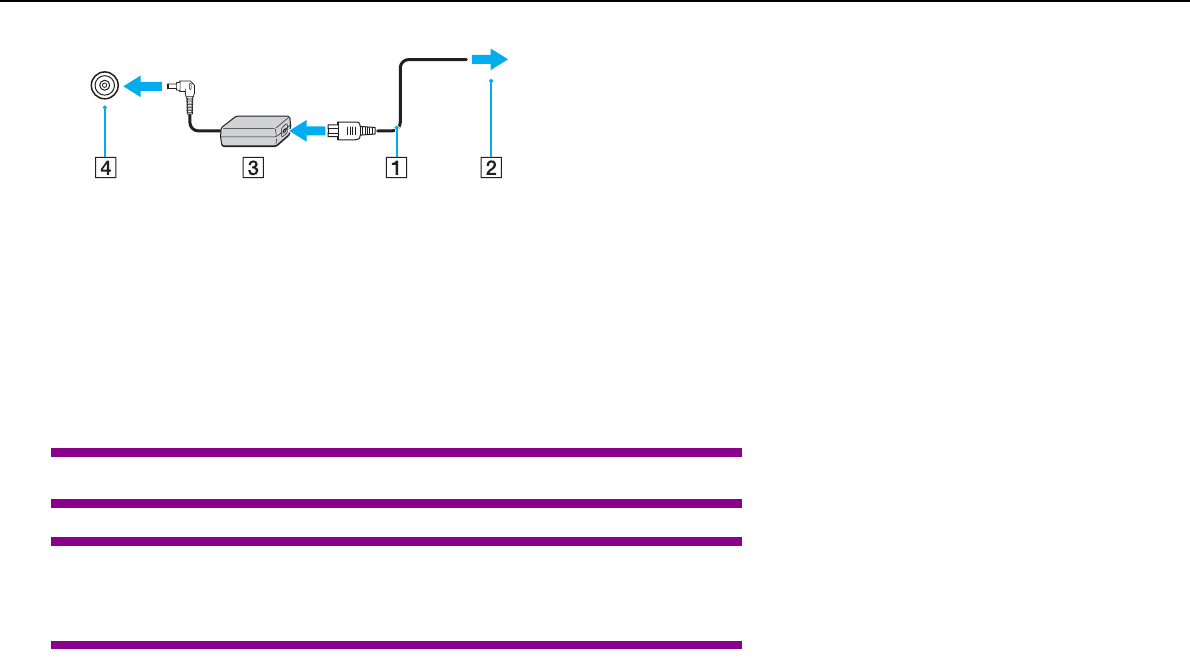
24
nN
Getting Started >
Using the Battery Pack
!
The shape of the DC In plug varies depending on the AC adapter.
✍
To disconnect your computer completely from AC power, unplug the AC adapter.
Make sure that the AC outlet is easily accessible.
If you do not intend to use your computer for a long period of time, place the computer into Hibernate mode. See Using Hibernate Mode (page 32).
Using the Battery Pack
Except IRX-4860_BGN
The battery pack supplied with your computer is not fully charged at the time of delivery.
Except IRX-4860_END
IRX-4860_BGN
The battery pack supplied with your computer is installed on your computer and is not charged at the time of delivery.
!
Do not use your computer without the battery pack installed as it may cause the computer to malfunction.
IRX-4860_END
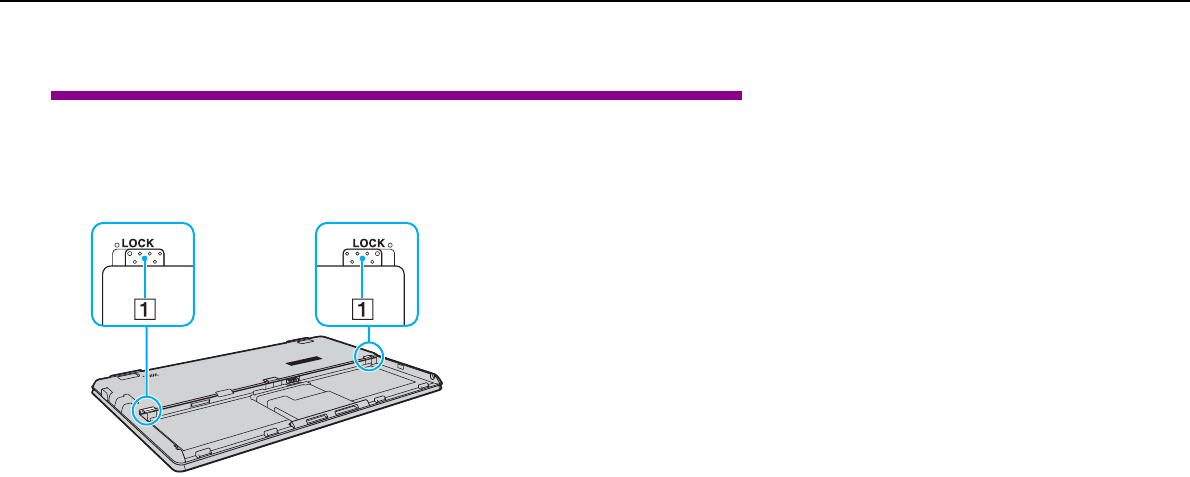
25
nN
Getting Started >
Using the Battery Pack
Installing/Removing the Battery Pack
IRX-4860_BGN
To install the battery pack
1Turn off the computer and close the LCD screen lid.
2Slide the battery LOCK switches (1) inward.
3Place the battery pack into the battery compartment until the projection (2) on either side of the battery pack fits into the
U-shaped cut (3) on either side of the battery compartment.
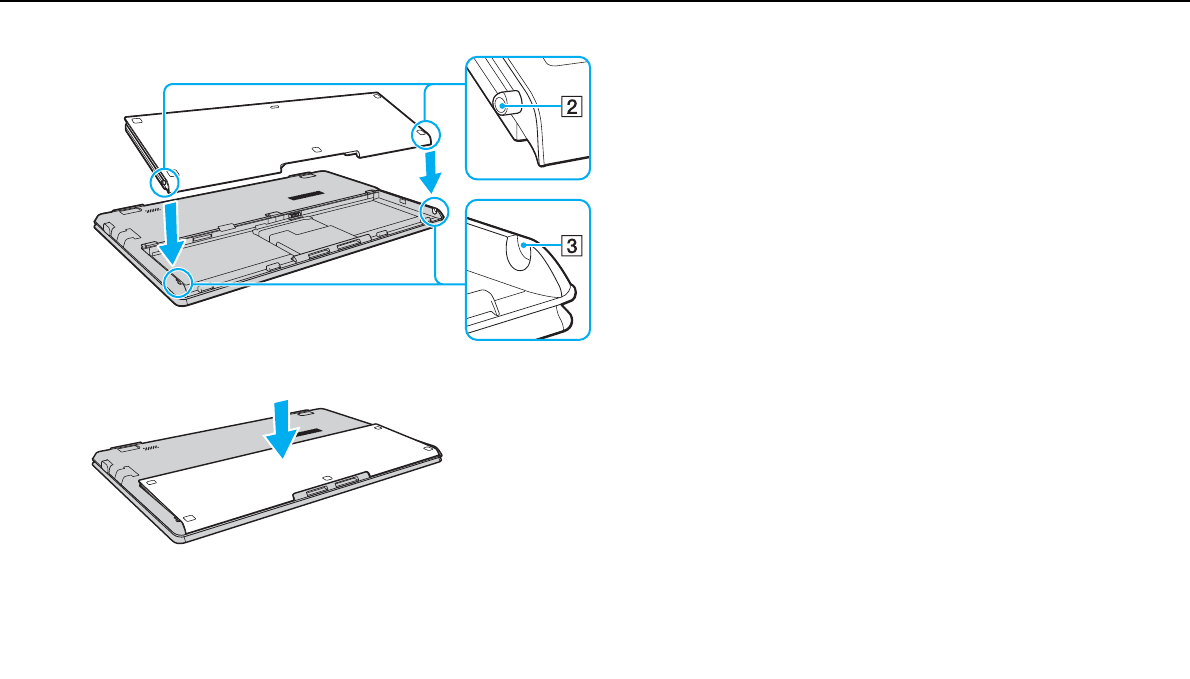
26
nN
Getting Started >
Using the Battery Pack
4Push the battery pack down into the compartment until it clicks into place.
5Slide the battery LOCK switches outward to secure the battery pack on the computer.
To remove the battery pack
!
You may lose data if you remove the battery pack while your computer is on and not connected to the AC adapter or if you remove the battery pack
while the computer is in Sleep mode.
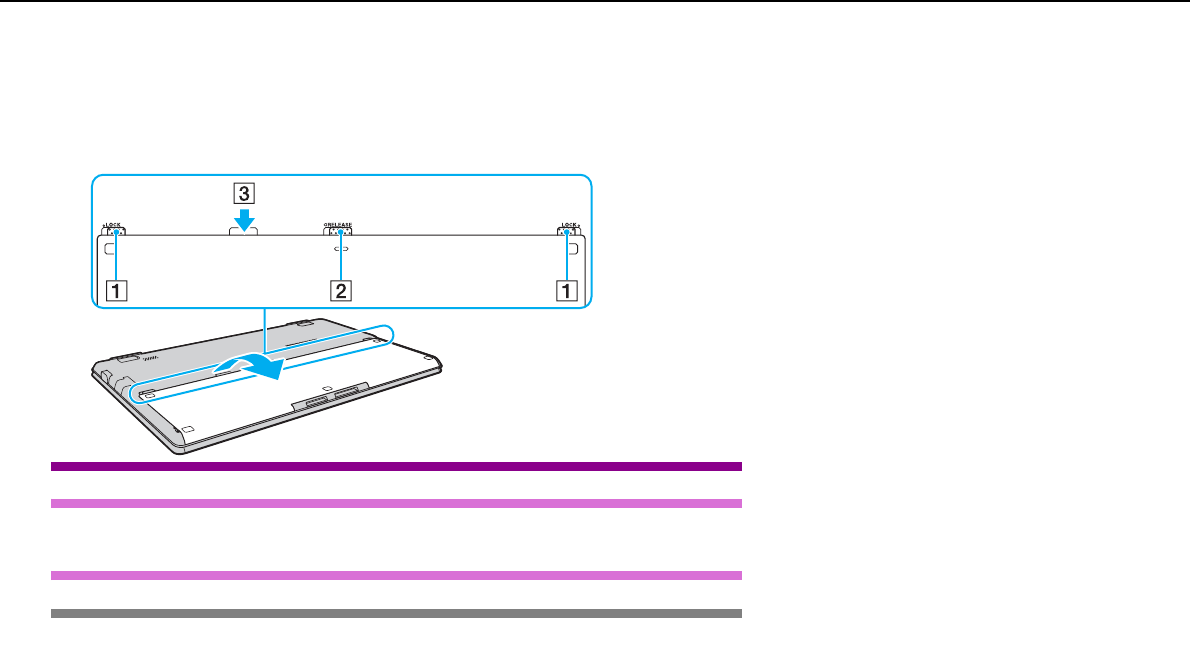
27
nN
Getting Started >
Using the Battery Pack
1Turn off the computer and close the LCD screen lid.
2Slide the battery LOCK switches (1) inward.
3Slide and hold the battery RELEASE latch (2) inward, put your fingertip underneath the tab (3) on the battery pack, and
lift the battery pack in the direction of the arrow, and then slide it away from the computer.
IRX-4860_END
US model_BGN
!
This computer is designed to operate only with genuine Sony battery packs.
US model_END
Euro model_BGN
!
Certain rechargeable batteries do not meet Sony quality and safety standards. For safety reasons this computer only functions with genuine Sony
battery packs designed for this model. If an unauthorized battery pack is installed, the battery will not be charged and the computer will not function.

28
nN
Getting Started >
Using the Battery Pack
Euro model_END
GVD model_BGN
!
For your safety, it is highly recommended that you use genuine Sony rechargeable battery packs and AC adapters that meet the quality assurance
standards and supplied by Sony for your VAIO computer. Some VAIO computers may operate only with genuine Sony battery packs.
GVD model_END
China model_BGN
!
For your safety, Sony recommends only using the genuine Sony battery packs that are designed to this model.
China model_END
Charging the Battery Pack
The battery pack supplied with your computer is not fully charged at the time of delivery.
To charge the battery pack
1Install the battery pack.
2Connect the computer to a power source with the AC adapter.
The charge indicator light is on while the battery pack is charging. When the battery pack charges close to the maximum
charge level you selected with the battery charge functions, the charge indicator turns off.
Charge indicator status Meaning
Lit in orange The battery pack is charging.
Blinks along with the green
power indicator
The battery pack is running out of power.
(Normal mode)
Blinks along with the orange
power indicator
The battery pack is running out of power.
(Sleep mode)

29
nN
Getting Started >
Using the Battery Pack
!
Charge the battery pack as described in this manual from your first battery charge.
✍
When the battery pack is running out of power and both the charge and power indicator lights blink, you should either connect the AC adapter to
recharge the battery pack or shut down your computer and install a fully charged battery pack.
Your computer is supplied with a lithium ion battery pack and can be recharged any time. Charging a partially discharged battery pack does not affect
the life of battery.
You can extend the life of your battery pack if you enable the battery care function of the Battery Charge Functions with the VAIO Control Center.
China model_BGN
By default, your computer enters Sleep mode automatically after about 30 minutes of inactivity when running on AC power. Press any key to bring it
back into Normal mode. When running on battery power, it switches the power saving mode automatically from Sleep mode to Hibernate mode if the
computer is not used for a certain period of time. To bring it back from Hibernate mode to Normal mode, press the power button.
China model_END
While some software applications or peripheral devices are in use, your computer may not enter Hibernate mode even when the remaining battery life
becomes short. To avoid loss of data while the computer is running on the battery, you should save your data frequently and manually activate a power
management mode, such as Sleep or Hibernate.
If the battery pack runs out of power while the computer is in Sleep mode, you will lose all unsaved data. Going back to the previous work state is
impossible. To avoid loss of data, you should save your data frequently.
When your computer is directly connected to AC power and has a battery pack installed, it uses power from the AC outlet.
Blinks fast in orange A battery error has occurred due to a failed battery
pack or an unlocked battery pack.
Charge indicator status Meaning

30
nN
Getting Started >
Shutting Down Your Computer Safely
Extending Your Battery Life
When your computer is running on battery power, you can extend your battery life using the following methods.
❑Decrease the LCD brightness of your computer screen.
❑Use the power saving mode. See Using the Power Saving Modes (page 30) for more information.
❑Change the power saving settings on the Windows Power Options. See Using the VAIO Power Management (page
84) for more information.
❑Set the wallpaper in Long Battery Life Wallpaper Setting as your desktop background with the VAIO Control Center.
Shutting Down Your Computer Safely
To avoid losing unsaved data, be sure to shut down your computer properly, as described below.
To shut down your computer
1Turn off any peripherals connected to the computer.
2Click Start and the Shut down button.
3Respond to any prompts warning you to save documents or to consider other users and wait for the computer to turn off
automatically.
The power indicator light turns off.
Using the Power Saving Modes
You can take advantage of the power management settings to conserve battery life. In addition to the normal operating mode,
your computer has two distinct power saving modes to suit your preference: Sleep and Hibernate.

31
nN
Getting Started >
Using the Power Saving Modes
!
If you do not intend to use your computer for a long period of time while it is disconnected from AC power, place the computer into Hibernate mode or
turn it off.
If the battery pack runs out of power while your computer is in Sleep mode, you will lose all unsaved data. Going back to the previous work state is
impossible. To avoid loss of data, you should save your data frequently.
Using Sleep Mode
To activate Sleep mode
Click Start, the arrow next to the Shut down button, and Sleep.
To return to Normal mode
❑Press any key.
❑Press the power button on your computer.
!
If you press and hold the power button for more than four seconds, your computer will turn off automatically. You will lose all unsaved data.
Mode Description
Normal mode This is the normal state of your computer while it is in use. The green power indicator light is lit while the
computer is in this mode.
Sleep mode Sleep mode turns off the LCD screen and places the built-in storage device(s) and the CPU into a low power
consumption mode. The orange power indicator light blinks slowly while your computer is in this mode. Your
computer comes out of Sleep mode quicker than out of Hibernate mode. However, Sleep mode uses more
power than Hibernate mode.
Hibernate mode While your computer is in Hibernate mode, the state of the system is saved on the built-in storage device(s) and
power is turned off. Even when the battery pack runs out of power, no data will be lost. The power indicator light
is unlit while your computer is in this mode.

32
nN
Getting Started >
Updating Your Computer
Using Hibernate Mode
To activate Hibernate mode
Press the Fn+F12 keys.
Alternatively, you can click Start, the arrow next to the Shut down button, and Hibernate.
!
Do not move your computer before its power indicator light turns off.
To return to Normal mode
Press the power button.
!
If you press and hold the power button for more than four seconds, your computer will turn off automatically.
Updating Your Computer
Be sure to install the latest updates on your computer with the following software applications so that the computer can run
more efficiently.
❑Windows Update
Click Start, All Programs, and Windows Update and then follow the on-screen instructions.
❑VAIO Update 4
Click Start, All Programs, VAIO Update 4, and Go to VAIO Web Support and then follow the on-screen instructions.
!
Your computer must be connected to the Internet to download the updates.

33
nN
Using Your VAIO Computer >
Using the Keyboard
Using Your VAIO Computer
This section describes how to get the most out of using your VAIO computer.
❑Using the Keyboard (page 33)
❑Using the Touch Pad (page 35)
❑Using the Built-in Camera (page 37)
❑Using "Memory Stick" (page 38)
❑Using Other Modules / Memory Cards (page 43)
❑Using the Internet (page 46)
❑Using the Network (LAN) (page 48)
❑Using the Wireless LAN (page 49)
Except US model_BGN
❑Using the Wireless WAN (page 56)
Except US model_END
❑Using the Bluetooth Function (page 60)
Euro model_BGN
❑Using the GPS Function (page 65)
Euro model_END
Using the Keyboard
Your keyboard has additional keys that perform model-specific tasks.

34
nN
Using Your VAIO Computer >
Using the Keyboard
Combinations and Functions with the Fn Key
✍
Some keyboard functions can be used only after the operating system is finished launching.
IRX-4860_BGN
Combination/Feature Function
Fn + % (F2): muting Turns on and off the built-in speakers or the headphones.
Fn + 2 (F3/F4): volume control Changes the volume level.
To increase the volume, keep pressing the Fn+F4 keys or press the Fn+F4 keys and then the
M or , key.
To decrease the volume, keep pressing the Fn+F3 keys or press the Fn+F3 keys and then the
m or < key.
Fn + 8 (F5/F6): brightness control Changes the LCD brightness of your computer screen.
To increase lighting intensity, keep pressing the Fn+F6 keys or press the Fn+F6 keys and then
the M or , key.
To decrease lighting intensity, keep pressing the Fn+F5 keys or press the Fn+F5 keys and then
the m or < key.
Fn + /T (F7): display output Switches the display output between your computer screen, an external display, simultaneous
output to both, and multiple displays with both that function as a single desktop. Press the Enter
key to select the display output.
!
If you select an external display as the display output destination when no external display is connected to
your computer, the computer screen goes blank. In such a case, press the Fn+F7 keys twice and then the
Enter key.
Multiple displays may not be supported depending on the operating system on your computer.
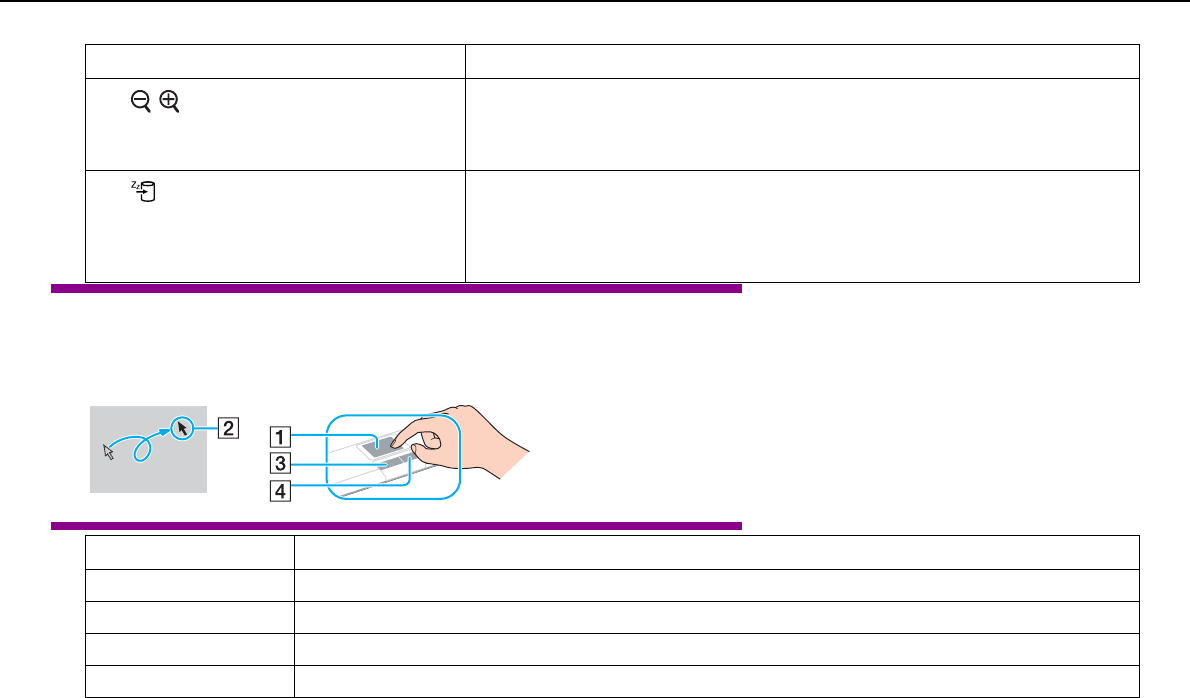
35
nN
Using Your VAIO Computer >
Using the Touch Pad
IRX-4860_END
Using the Touch Pad
You can point to, select, drag, and scroll objects on the screen using the touch pad.
Except IRX-4860_BGN
Fn + / (F9/F10): zooming Changes the size of an image or a document displayed on some software.
To make the view look smaller and further away (zoom out), press the Fn+F9 keys.
To make the view look bigger and closer (zoom in), press the Fn+F10 keys.
See the help file included with the VAIO Control Center for more information.
Fn + (F12): hibernation Provides the lowest level of power consumption. When you execute this command, the states
of the system and the connected peripheral devices are saved to the built-in storage device and
the system power is turned off. To return the system to its original state, use the power button
to turn on the power.
For details on power management, see Using the Power Saving Modes (page 30).
Action Description
Point Slide your finger on the touch pad (1) to place the pointer (2) on an item or object.
Click Press the left button (3) once.
Double-click Press the left button twice in a row.
Right-click Press the right button (4) once. With many applications, this action displays a context-sensitive shortcut menu (if any).
Combination/Feature Function

36
nN
Using Your VAIO Computer >
Using the Touch Pad
Except IRX-4860_END
IRX-4860_BGN
Drag Slide your finger on the touch pad while pressing the left button.
Scroll Slide your finger along the right edge of the touch pad to scroll vertically. Slide your finger along the bottom edge to scroll
horizontally (the scroll function is available only with applications that support a touch pad scroll feature).
Slide your finger along the right edge of the touch pad to scroll vertically. Slide your finger along the bottom edge to scroll
horizontally. Once vertical or horizontal scrolling is engaged, you can move your finger in circles on the touch pad to
keep scrolling without taking the finger off the touch pad (the scroll function is available only with applications that
support a touch pad scroll feature).
Action Description
Point Slide your finger on the touch pad (1) to place the pointer (2) on an item or object.
Click Press the left button (3) once.
Double-click Press the left button twice in a row.
Right-click Press the right button (4) once. With many applications, this action displays a context-sensitive shortcut menu (if any).
Drag Slide your finger on the touch pad while pressing the left button.
Scroll Slide your finger along the right edge of the touch pad to scroll vertically. Slide your finger along the bottom edge to scroll
horizontally. Once vertical or horizontal scrolling is engaged, you can move your finger in circles on the touch pad to
keep scrolling without taking the finger off the touch pad (the scroll function is available only with applications that
support a touch pad scroll feature).
Flick Slide your finger linearly in quick motion on the touch pad. On web browser software or image viewer software, you can
flick left to move backward and flick right to move forward.
Pinch With some software applications, you can pinch on the touch pad with two fingers for zooming. Pinch open to zoom in
or pinch close to zoom out.
Action Description

37
nN
Using Your VAIO Computer >
Using the Built-in Camera
IRX-4860_END
✍
You can disable/enable the touch pad while a mouse is connected to your computer. To change the touch pad settings, use the VAIO Control Center.
!
Be sure to connect a mouse before disabling the touch pad. If you disable the touch pad before connecting a mouse, you will be able to use only the
keyboard for pointer operations.
Using the Built-in Camera
Your computer is equipped with a built-in MOTION EYE camera.
Except IRX-4860_BGN
With the preinstalled image capture software, you can perform the following operations:
❑Capturing still images and movies
❑Sensing and capturing object movements for monitoring purposes
❑Editing captured data
Except IRX-4860_END
IRX-4860_BGN
With the communication software, such as the Skype, you can join a video conference through the Internet.
IRX-4860_END
✍
Turning on the computer activates the built-in camera.
Video conferences are possible with the appropriate software.

38
nN
Using Your VAIO Computer >
Using "Memory Stick"
!
Launching or exiting your instant messaging or video editing software does not activate or deactivate the built-in camera.
Do not place your computer into Sleep or Hibernate mode while you are using the built-in camera.
Except IRX-4860_BGN
To use the preinstalled image capture software
1Click Start, All Programs, ArcSoft WebCam Companion 3, and WebCam Companion 3.
2Click your desired icon in the main window.
For detailed information on how to use the software, see the help file included with the software.
✍
When capturing an image or a movie in a dark place, click the Capture icon in the main window, and then click the WebCam Settings icon and select
the low light or low light compensation option in the properties window.
Except IRX-4860_END
Using "Memory Stick"
"Memory Stick" is a compact, portable, and versatile IC recording media especially designed for exchanging and sharing
digital data with compatible products, such as digital cameras, mobile phones, and other devices. Because it is removable,
it can be used for external data storage.
Before You Use "Memory Stick"
Except IRX-4860_BGN
The "Memory Stick Duo" slot on your computer can accommodate both standard- and Duo-size media and supports "Memory
Stick PRO", "Memory Stick PRO Duo", and "Memory Stick PRO-HG Duo" with high-speed data transfer and large data
capacity capabilities.

39
nN
Using Your VAIO Computer >
Using "Memory Stick"
Except IRX-4860_END
IRX-4860_BGN
The "Memory Stick Duo" slot on your computer can accommodate Duo-size media and supports "Memory Stick PRO Duo"
and "Memory Stick PRO-HG Duo" with high-speed data transfer and large data capacity capabilities.
IRX-4860_END
For the latest information about "Memory Stick", visit [memorystick.com] at http://www.memorystick.com/en/.
Inserting and Removing "Memory Stick"
To insert "Memory Stick"
1Locate the "Memory Stick Duo" slot.
2Hold "Memory Stick" with the arrow facing upward and pointing toward the slot.
3Carefully slide "Memory Stick" into the slot until it clicks into place.
✍
"Memory Stick" is automatically detected by your system and the contents of "Memory Stick" are displayed. If nothing appears on the desktop, click
Start, Computer, and double-click the "Memory Stick" icon.
IRX-4860_BGN
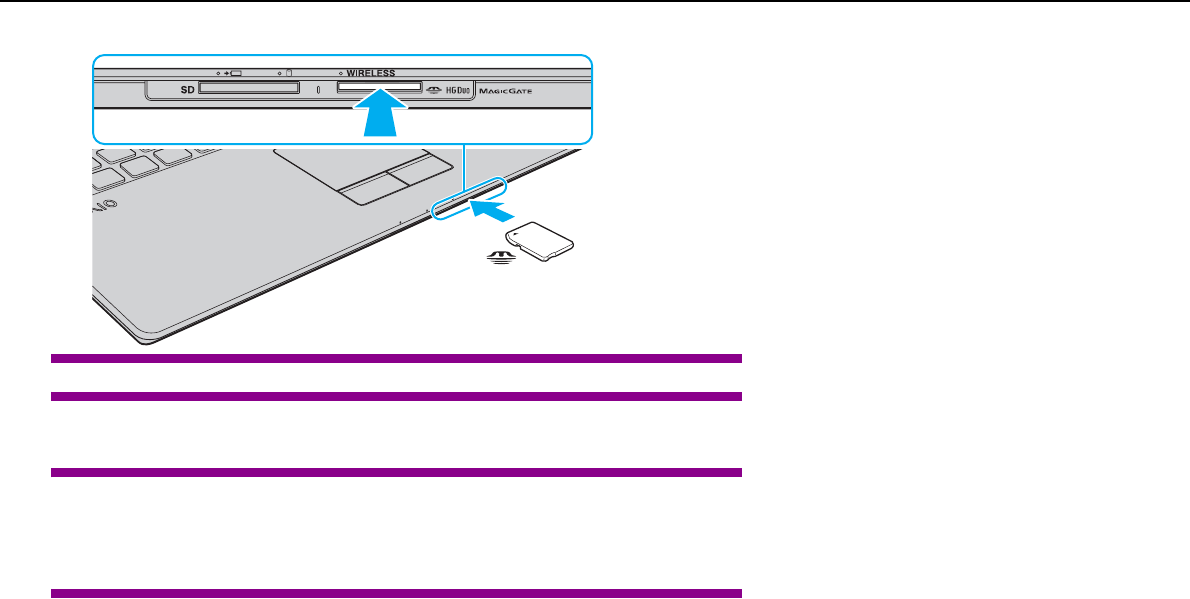
40
nN
Using Your VAIO Computer >
Using "Memory Stick"
IRX-4860_END
Except IRX-4860_BGN
✍
You can insert Duo-size "Memory Stick" directly into the "Memory Stick" slot without using a "Memory Stick Duo" adaptor.
Except IRX-4860_END
!
Be sure to hold "Memory Stick" with the arrow pointing in the correct direction as you insert it into the slot. To avoid damaging your computer or the
media, do not force "Memory Stick" into the slot if you cannot insert it smoothly.
Except IRX-4860_BGN
Before using "Memory Stick Micro" ("M2"), be sure to insert it into an "M2" Standard-size adaptor or "M2" Duo adaptor. If you insert the media directly
into the "Memory Stick" slot without the adaptor, you may not be able to remove it from the slot.
"Memory Stick Micro" in an "M2" Duo adaptor may not operate properly if it is additionally inserted into a "Memory Stick Duo" adaptor.

41
nN
Using Your VAIO Computer >
Using "Memory Stick"
Except IRX-4860_END
IRX-4860_BGN
Before using "Memory Stick Micro" ("M2"), be sure to insert it into an "M2" Duo adaptor. If you insert the media directly into the "Memory Stick Duo"
slot without the adaptor, you may not be able to remove it from the slot.
IRX-4860_END
To remove "Memory Stick"
!
Do not remove "Memory Stick" while the Media Access indicator light is lit. If you do, you may lose data. Large volumes of data may take time to load,
so make sure the indicator light is unlit before removing "Memory Stick".
1Check that the Media Access indicator light is unlit.
2Push in "Memory Stick" toward the computer and release.
"Memory Stick" ejects.
3Pull "Memory Stick" out of the slot.
!
Be sure to remove "Memory Stick" gently, or it may pop out unexpectedly.
Formatting "Memory Stick"
To format "Memory Stick"
"Memory Stick" has been formatted by default and is ready for use.
If you want to reformat the media with your computer, follow these steps.

42
nN
Using Your VAIO Computer >
Using "Memory Stick"
!
Be sure to use the device that is designed to format the media and supports "Memory Stick" when formatting the media.
Formatting "Memory Stick" erases the entire data stored on the media. Before formatting the media, make sure that it does not contain your valuable
data.
Do not remove "Memory Stick" from the slot while formatting. This could cause a malfunction.
1Carefully slide "Memory Stick" into the slot until it clicks into place.
2Click Start and Computer to open the Computer window.
3Right-click the "Memory Stick" icon and select Format.
4Click Restore device defaults.
!
The size of the allocation unit and file system may change.
Do not select NTFS from the File system drop-down list as it may cause a malfunction.
✍
The formatting process will be completed more quickly if you select Quick Format in Format options.
5Click Start.
6Follow the on-screen instructions.
!
It may take time to format "Memory Stick" depending on the media type.
Notes on Using "Memory Stick"
❑Your computer has been tested and found compatible with Sony branded "Memory Stick" with capacity of up to 16 GB
that are available as of May 2009. However, not all "Memory Stick" that meet the same specifications as the compatible
media are guaranteed of compatibility.

43
nN
Using Your VAIO Computer >
Using Other Modules / Memory Cards
❑Inserting "Memory Stick" with multiple conversion adaptors is not guaranteed of compatibility.
❑"MagicGate" is the general name of the copyright protection technology developed by Sony. Use "Memory Stick" with the
"MagicGate" logo to take advantage of this technology.
❑Except for your personal use, it is against the copyright law to use any audio and/or image data you recorded without prior
consent from the respective copyright holders. Accordingly, "Memory Stick" with such copyrighted data can be used only
within the law.
Except IRX-4860_BGN
❑The "Memory Stick Duo" slot on your computer does not support 8-bit parallel data transfer (high-speed data transfer).
Except IRX-4860_END
❑Do not insert more than one "Memory Stick" into the slot. Improper insertion of the media may damage both your
computer and the media.
Using Other Modules / Memory Cards
Using the SD Memory Card
Your computer is equipped with an SD memory card slot. You can use this slot to transfer data among digital cameras,
camcorders, music players, and other audio/video devices.
Before you use the SD memory card
The SD memory card slot on your computer supports the following memory cards:
❑SD memory card
❑SDHC memory card
For the latest information on compatible memory cards, see Finding More about Your VAIO Computer (page 6) to visit the
appropriate support web site.

44
nN
Using Your VAIO Computer >
Using Other Modules / Memory Cards
To insert an SD memory card
1Locate the SD memory card slot.
2Hold the SD memory card with the arrow facing upward and pointing toward the slot.
3Carefully slide the SD memory card into the slot until it clicks into place.
Do not force the card into the slot.
IRX-4860_BGN
IRX-4860_END
✍
If the SD memory card does not go into the slot easily, remove it gently and verify you are inserting it in the proper direction.
To remove an SD memory card
1Check that the Media Access indicator light is unlit.

45
nN
Using Your VAIO Computer >
Using Other Modules / Memory Cards
2Push in the SD memory card toward the computer and release.
The SD memory card ejects.
3Pull the SD memory card out of the slot.
Notes on Using Memory Cards
General notes on using the memory card
❑Be sure to use memory cards that are compliant with the standards supported by your computer.
❑Be sure to hold the memory card with the arrow pointing in the correct direction as you insert it into the slot. To avoid
damaging your computer or the media, do not force the memory card into the slot if you cannot insert it smoothly.
❑Use care when inserting or removing the memory card from the slot. Do not force it in or out of the slot.
❑Do not remove the memory card while the media access indicator light is lit. If you do, you may lose data.
❑Do not attempt to insert a memory card or memory card adaptor of a different type into the memory card slot. An
incompatible memory card or memory card adaptor may cause difficulty in removing from the slot and can cause damage
to your computer.
Notes on using the SD memory card
❑Your computer has been tested and found compatible only with major memory cards available as of May 2009. However,
not all memory cards that meet the same specifications as the compatible media are guaranteed of compatibility.
❑SD memory cards with capacity of up to 2 GB and SDHC memory cards with capacity of up to 32 GB have been tested
and found compatible with your computer.
❑The SD memory card slot on your computer does not support the high-speed data transfer feature of the SD memory
card and the SDHC memory card.

46
nN
Using Your VAIO Computer >
Using the Internet
Using the Internet
Before using the Internet, you need to sign up with an Internet Service Provider (ISP) and set up devices required for
connecting your computer to the Internet.
The following types of Internet connection services may be available from your ISP:
❑Fiber to the Home (FTTH)
❑Digital Subscriber Line (DSL)
❑Cable modem
❑Satellite
❑Dial-up
For detailed information on devices required for Internet access and how to connect your computer to the Internet, ask your
ISP.
✍
To connect your computer to the Internet using the wireless LAN function, you need to set up the wireless LAN network. See Using the Wireless LAN
(page 49) for more information.
!
When you connect your computer to the Internet, be sure to take appropriate security measures to protect the computer against online threats.
IRX-4860_BGN
Depending on the service contract with your ISP, you may need to connect an external modem device, for example a USB telephone modem, a DSL
modem, or a cable modem, to your computer to connect to the Internet. For the detailed instructions on connection setups and modem configuration,
see the manual that came with your modem.
IRX-4860_END
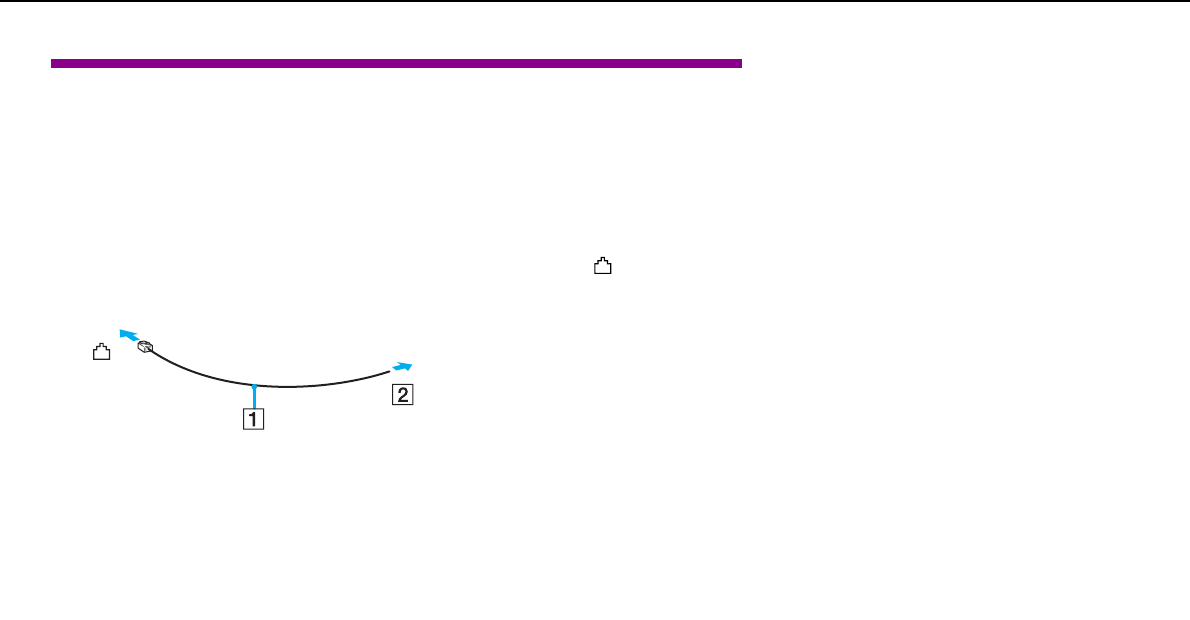
47
nN
Using Your VAIO Computer >
Using the Internet
Except IRX-4860_BGN
If your computer is not equipped with a built-in modem, you may need to connect an external modem device, for example a USB telephone modem, a
DSL modem, or a cable modem, to your computer. For the detailed instructions on connection setups and modem configuration, see the manual that
came with your modem.
To connect a telephone cable
!
The following procedure applies to models with a built-in modem only.
1Plug one end of the phone cable (1) into the modem port on the computer.
2Plug the other end into the wall jack (2).
!
Your computer does not work with party lines, cannot be connected to a coin-operated telephone, and may not work with multiple telephone lines or a
private branch exchange (PBX). Some of these connections may result in excess electrical current and could cause a malfunction in the built-in modem.
If you connect a telephone cable coming through a splitter, the modem or connected device may not work properly.
To set up a dial-up connection to the Internet
!
The following procedure applies to models with a built-in modem only.
1Click Start and Control Panel.
2Click Network and Internet.

48
nN
Using Your VAIO Computer >
Using the Network (LAN)
3Click Network and Sharing Center.
4Click Set up a new connection or network.
5Click Set up a dial-up connection and Next.
6Follow the on-screen instructions.
Except IRX-4860_END
Using the Network (LAN)
You can connect your computer to 1000BASE-T/100BASE-TX/10BASE-T type networks with a LAN cable. Connect one end
of a LAN cable (not supplied) to the network (LAN) port on the computer and the other end to your network. For detailed
settings and devices required for LAN access, ask your network administrator.
IRX-4860_BGN
!
You need to unfold the tilt feet before using the network (LAN) port on your computer.
IRX-4860_END

49
nN
Using Your VAIO Computer >
Using the Wireless LAN
✍
You can connect your computer to any network without changing the default settings.
!
Do not plug a telephone cable into the network (LAN) port on your computer.
If the network (LAN) port is connected to one of the telephone lines mentioned below, high electric current to the port may cause damage, overheating,
or fire.
- Home (intercom speakerphone) or business-use telephone lines (multi-line business telephone)
- Public telephone subscriber line
- Private branch exchange (PBX)
Using the Wireless LAN
Using the Wireless LAN (WLAN), all your digital devices with the built-in WLAN function communicate freely with each other
through a network. A WLAN is a network in which a user can connect to a Local Area Network (LAN) through a wireless (radio)
connection.
The WLAN supports all normal LAN connectivity, but with the added benefits of mobility and roaming. You can still access
information, Internet/intranet and network resources, even in the middle of a meeting, or as you move from one place to
another.
You can communicate without an access point, which means that you can communicate with a limited number of computers
(ad-hoc). Or you can communicate through an access point, which allows you to create a full infrastructure network.
US model_BGN

50
nN
Using Your VAIO Computer >
Using the Wireless LAN
To use the wireless LAN function
!
Be sure to turn on the WIRELESS switch before starting the wireless LAN function.
The IEEE 802.11a standard, using the 5 GHz band, and the IEEE 802.11n draft standard, using the 2.4 GHz or 5 GHz band, are not available on ad-hoc
networks.
To use the wireless LAN function, you first need to set up the wireless LAN function.
Use the SmartWi Connection Utility to set up the wireless LAN function. See the SmartWi Connection Utility Help for
more information.
To access this on-screen guide:
1Click Start, All Programs, and SmartWi Connection Utility.
2Click SmartWi Connection Utility Help.
✍
In some countries, using WLAN products may be restricted by the local regulations (e.g. limited number of channels). Therefore, before activating the
WLAN function, read the Safety Information carefully.
US model_END
Euro model_BGN
✍
In some countries, using WLAN products may be restricted by the local regulations (e.g. limited number of channels). Therefore, before activating the
WLAN function, read the wireless LAN regulations guide carefully.
Euro model_END
Except Euro_BGN
Except US model_BGN

51
nN
Using Your VAIO Computer >
Using the Wireless LAN
✍
In some countries, using WLAN products may be restricted by the local regulations (e.g. limited number of channels). Therefore, before activating the
WLAN function, read the Safety Regulations carefully.
Except US model_END
Except Euro_END
WLAN uses the IEEE 802.11a*/b/g standard or the IEEE 802.11n* draft standard, which specifies the type of technology used. The standard includes
the encryption methods: Wired Equivalent Privacy (WEP), which is a security protocol, Wi-Fi Protected Access 2 (WPA2), and Wi-Fi Protected Access
(WPA). Proposed jointly by the IEEE and Wi-Fi Alliance, both WPA2 and WPA are specifications of standards based on interoperable security
enhancements that increase the level of data protection and access control for existing Wi-Fi networks. WPA is designed to be forward compatible with
the IEEE 802.11i specification. It utilizes the enhanced data encryption Temporal Key Integrity Protocol (TKIP) in addition to user authentication using
802.1X and Extensible Authentication Protocol (EAP). Data encryption protects the vulnerable wireless link between clients and access points. Besides
that, there are other typical LAN security mechanisms to ensure privacy, such as: password protection, end-to-end encryption, virtual private networks,
and authentication. WPA2, the second generation of WPA, provides stronger data protection and network access control and is also designed to secure

52
nN
Using Your VAIO Computer >
Using the Wireless LAN
all versions of 802.11 devices, including 802.11b, 802.11a, 802.11g, and 802.11n draft standard, multi-band and multi-mode. In addition, based on
the ratified IEEE 802.11i standard, WPA2 provides government grade security by implementing the National Institute of Standards and Technology
(NIST) FIPS 140-2 compliant AES encryption algorithm and 802.1X-based authentication. WPA2 is backward compatible with WPA.
* See the specifications to find out about the configuration of your computer.
The IEEE 802.11b/g standard is a wireless LAN standard, using the 2.4 GHz band. The IEEE 802.11g standard provides higher-speed communications
than the IEEE 802.11b standard.
The IEEE 802.11a standard is a wireless LAN standard, using the 5 GHz band.
The IEEE 802.11n draft standard is a wireless LAN standard, using the 2.4 GHz or 5 GHz band.
Wireless LAN devices using the 2.4 GHz band cannot communicate with devices using the 5 GHz band because the frequencies are different.
The 2.4 GHz band used by wireless LAN compatible devices is also used by other various devices. Although technologies to minimize interference from
other devices that use the same band are employed on wireless LAN compatible devices, such interference may cause lower communication speed,
narrower communication range, or broken wireless connections.
The communication speed varies depending on the distance between communication devices, existence of obstacles between such devices, the device
configuration, the radio conditions, and the software in use. In addition, communications may be cut off depending on the radio conditions.
The communication range varies depending on the actual distance between communication devices, existence of obstacles between such devices, the
radio conditions, the ambient environment that includes existence of walls and materials of such walls, and the software in use.
Actual communication speed may not be as fast as the one displayed on your computer.
Deploying IEEE 802.11b and IEEE 802.11g products on the same wireless network may reduce the communication speed due to radio interference.
Taking this into consideration, the IEEE 802.11g products are designed to reduce the communication speed to ensure communications with
IEEE 802.11b products. When the communication speed is not as fast as expected, changing the wireless channel on the access point may increase
the communication speed.
Except US model_BGN
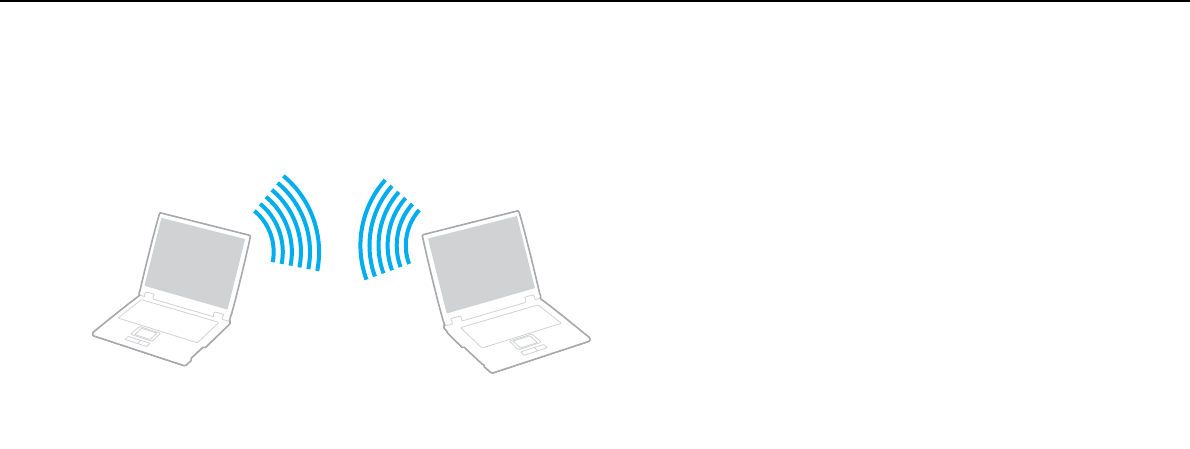
53
nN
Using Your VAIO Computer >
Using the Wireless LAN
Communicating without an Access Point (Ad-hoc)
An ad-hoc network is a network in which a LAN is created only by wireless devices themselves, with no other central controller
or access point. Each device communicates directly with other devices in the network. You can set up an ad-hoc network
easily at home.
To communicate without an access point (ad-hoc)
!
The IEEE 802.11a standard, using the 5 GHz band, and the IEEE 802.11n draft standard, using the 2.4 GHz or 5 GHz band, are not available on ad-hoc
networks.
1Turn on the WIRELESS switch.
2Click the VAIO Smart Network icon on the taskbar and select Show main window.
3Click the switch next to your desired wireless option(s) to toggle it to On in the VAIO Smart Network window.
Make sure the WIRELESS indicator light turns on.
4Click Start and Control Panel.
5Click View network status and tasks under Network and Internet.
6Click Set up a new connection or network.
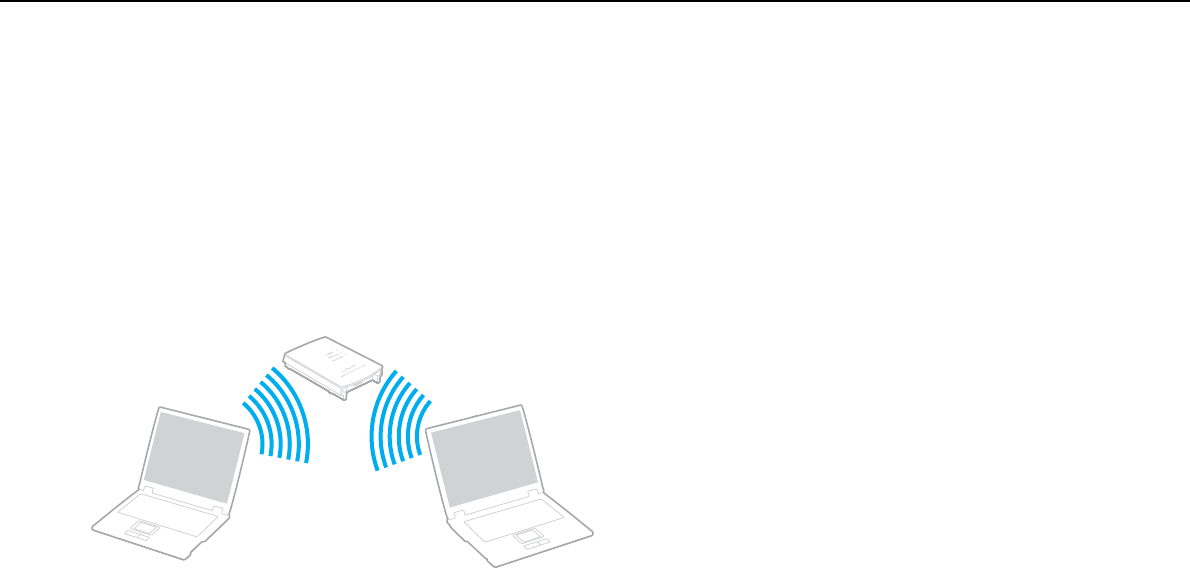
54
nN
Using Your VAIO Computer >
Using the Wireless LAN
7Select an option to specify the ad-hoc network settings and click Next.
8Follow the on-screen instructions.
Communicating with an Access Point (Infrastructure)
An infrastructure network is a network that extends an existing wired local network to wireless devices by providing an access
point (not supplied). The access point bridges the wireless and wired LAN and acts as a central controller for the wireless
LAN network. The access point coordinates transmission and reception from multiple wireless devices within a specific range.
The access point will select which channel to use on an infrastructure network.
!
For details on how to select the channel that will be used by the access point, see the manual that came with your access point.
To connect to a wireless network
1Make sure an access point is set up.
See the manual that came with your access point for more information.
2Turn on the WIRELESS switch.

55
nN
Using Your VAIO Computer >
Using the Wireless LAN
3Click the VAIO Smart Network icon on the taskbar and select Show main window.
4Click the switch next to your desired wireless option(s) to toggle it to On in the VAIO Smart Network window.
Make sure the WIRELESS indicator light turns on.
Euro model_BGN
Except IRX-4860_BGN
!
Wireless LAN communication (IEEE 802.11a standard) using only the 5 GHz band, available on selected models only, is disabled by default. To enable
5 GHz band communication, you need to select the option to use the 5 GHz band or both the 2.4 GHz and 5 GHz bands from the drop-down list for
Wireless LAN Settings in the VAIO Smart Network settings window.
Euro model_END
GVD model_BGN
!
Wireless LAN communication (IEEE 802.11a standard) using only the 5 GHz band, available on selected models only, is disabled by default. To enable
5 GHz band communication, you need to select the option to use the 5 GHz band or both the 2.4 GHz and 5 GHz bands from the drop-down list for
Wireless LAN Settings in the VAIO Smart Network settings window.
GVD model_END
China model_BGN
!
Wireless LAN communication (IEEE 802.11a standard) using only the 5 GHz band, available on selected models only, is disabled by default. To enable
5 GHz band communication, you need to select the option to use the 5 GHz band or both the 2.4 GHz and 5 GHz bands from the drop-down list for
Wireless LAN Settings in the VAIO Smart Network settings window.
China model_END
Except IRX-4860_END
5Right-click or on the taskbar and select Connect to a network.
6Select the desired access point and click Connect.

56
nN
Using Your VAIO Computer >
Using the Wireless WAN
✍
For WPA-PSK or WPA2-PSK authentication, you must enter a passphrase. The passphrase is case sensitive and must be a text string between 8 and
63 characters in length or a hexadecimal string of 64 characters.
Stopping Wireless LAN Communications
To stop wireless LAN communications
Click the switch next to Wireless LAN to toggle it to Off in the VAIO Smart Network window.
!
Turning off the wireless LAN function while accessing remote documents, files, or resources may result in data loss.
Except US model_END
Except US model_BGN
Using the Wireless WAN
Using the wireless WAN (WWAN) allows your computer to connect to the Internet through the wireless network wherever
there is the mobile phone coverage.
Euro model_BGN
The WWAN may not be available in some countries or areas. See Wireless WAN Regulations Guide in Regulations,
Guarantee, and Service Support to find out in which countries or areas the WWAN is available.
Euro model_END
Features and options in this section may not be available on your computer.
See the specifications to find out about the configuration of your computer.
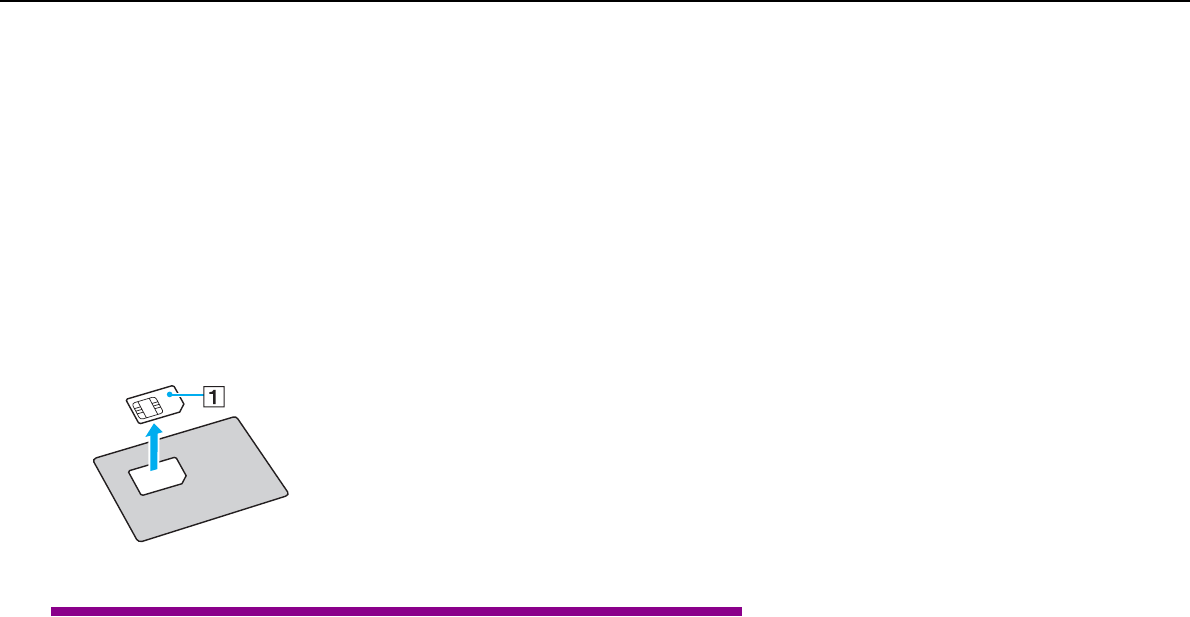
57
nN
Using Your VAIO Computer >
Using the Wireless WAN
Inserting a SIM Card
To use the wireless WAN function, you first need to insert a SIM card into the SIM card slot on your computer. Your SIM card
is contained within a base plate, about the size of a credit card.
✍
Depending on your country and model, you might receive an offer from the VAIO selected telecom operator. In that case the SIM card is either in the
operator SIM pack inside the carton box or already inserted in the SIM card slot. If the SIM card is not provided with your computer, you can purchase
one from your preferred telecom operator.
To insert a SIM card
1Turn off your computer.
2Remove the battery pack from the computer.
3Remove the SIM card (1) by pushing it out from the base plate.
4Insert the SIM card into the SIM card slot with its printed circuit side down.
IRX-4860_BGN
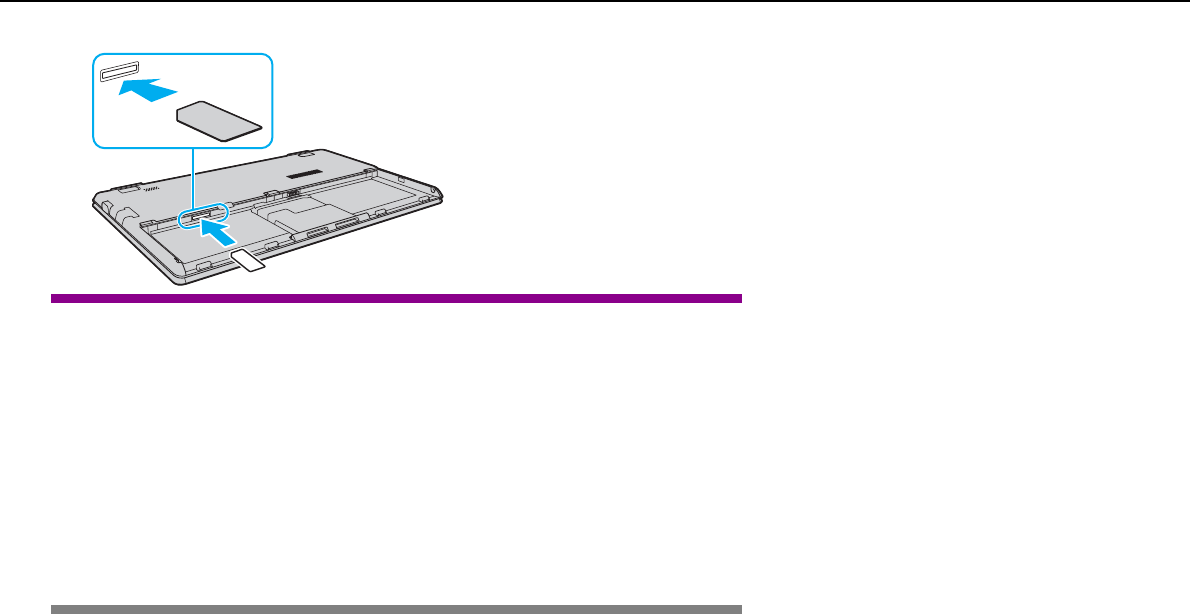
58
nN
Using Your VAIO Computer >
Using the Wireless WAN
IRX-4860_END
!
Do not touch the printed circuit on the SIM card. Be sure to hold your computer firmly before inserting or removing the card.
Do not damage the SIM card in any way, either by bending or exerting pressure on the card.
5Reinstall the battery pack.
!
Make sure the battery pack is installed properly.
Starting the Wireless WAN Communications
To start the wireless WAN communications
Euro model_BGN
1Turn on the WIRELESS switch.
2Click the VAIO Smart Network icon on the taskbar and select Show main window.
3Click the switch next to Wireless WAN to toggle it to On in the VAIO Smart Network window.

59
nN
Using Your VAIO Computer >
Using the Wireless WAN
4Click the down arrow button next to the WWAN switch and the Connect button to launch Mobile Broadband
Connection.
✍
Depending on your model, country, or area, you might need to use the GlobeTrotter Connect, the 3G Connection Manager, or the software specified
by a telecom operator in order to connect to a network.
5Enter your PIN code when prompted.
6if requested, enter the APN information of your telecom operator.
Euro model_END
GVD model_BGN
1Turn on the WIRELESS switch.
2Click the VAIO Smart Network icon on the taskbar and select Show main window.
3Click the switch next to Wireless WAN to toggle it to On in the VAIO Smart Network window.
4Launch the Windows Network Connection.
5Enter your PIN code when prompted.
6If requested, enter the APN information of your telecom operator.
7Click Connect.
GVD model_END
China model_BGN
Pending
China model_END
For more information on how to use the wireless WAN function, see the help file included with the VAIO Smart Network
software or your telecom operator's documentation.

60
nN
Using Your VAIO Computer >
Using the Bluetooth Function
Except US model_END
Using the Bluetooth Function
US model_BGN
You can establish wireless communications between your computer and other Bluetooth devices such as another computer
or a mobile phone. You can transfer data between these devices without cables at a range of up to 33 feet (10 meters) in an
open area.
To use the Bluetooth function
!
Be sure to turn on the WIRELESS switch before starting the Bluetooth function.
To use the Bluetooth function, you first need to set up the Bluetooth function.
Use the SmartWi Connection Utility to set up the Bluetooth function. See the SmartWi Connection Utility Help for more
information.
To access this on-screen guide:
1Click Start, All Programs, and SmartWi Connection Utility.
2Click SmartWi Connection Utility Help.
US model_END
Euro model_BGN
You can establish wireless communications between your computer and other Bluetooth® devices such as another computer
or a mobile phone. You can transfer data between these devices without cables at a range of up to 10 meters in an open area.
Euro model_END
GVD model_BGN

61
nN
Using Your VAIO Computer >
Using the Bluetooth Function
You can establish wireless communications between your computer and other Bluetooth® devices such as another computer
or a mobile phone. You can transfer data between these devices without cables at a range of up to 10 meters in an open area.
GVD model_END
China model_BGN
You can establish wireless communications between your computer and other Bluetooth® devices such as another computer
or a mobile phone. You can transfer data between these devices without cables at a range of up to 10 meters in an open area.
China model_END
Bluetooth Security
The Bluetooth wireless technology has an authentication function, which allows you to determine with whom you choose to
communicate. With the authentication function, you can prevent any anonymous Bluetooth devices from accessing your
computer.
The first time two Bluetooth devices communicate, a common passkey (a password required for authentication) should be
determined for both devices to be registered. Once a device is registered, there is no need to re-enter the passkey.
✍
The passkey can be different each time, but must be the same at both ends.
For certain devices, such as a mouse, no passkey can be entered.
Communicating with Another Bluetooth Device
You can connect your computer to a Bluetooth device such as another computer, a mobile phone, a PDA, a headset, a
mouse, or a digital camera without the use of any cables.
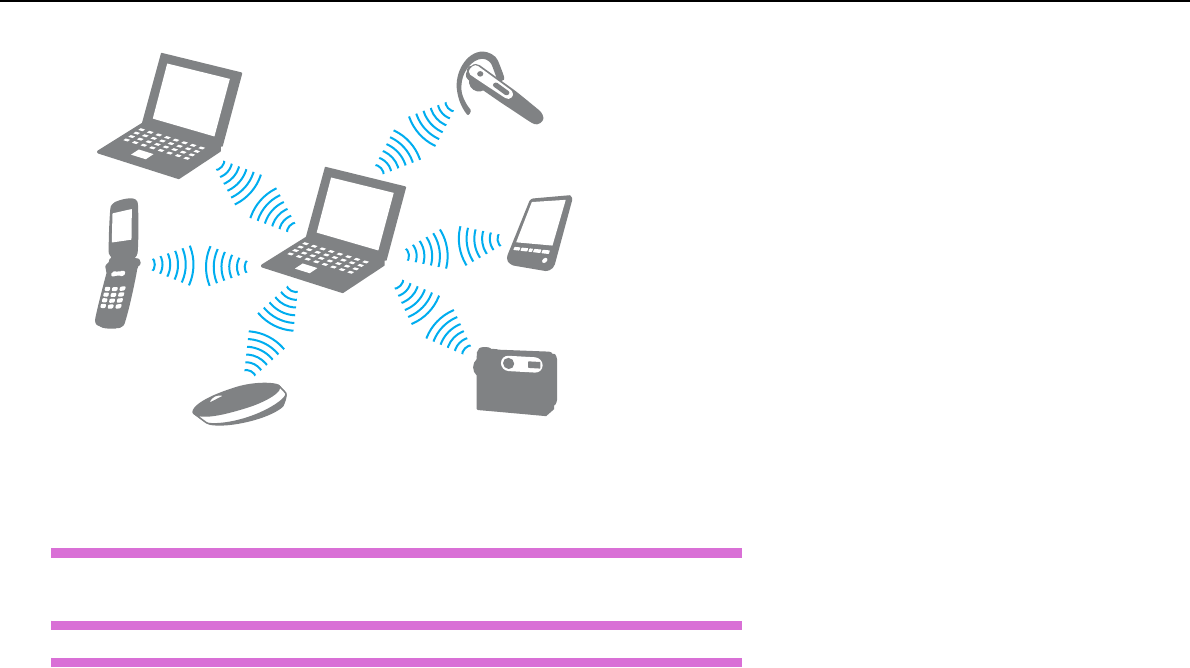
62
nN
Using Your VAIO Computer >
Using the Bluetooth Function
To communicate with another Bluetooth device
To communicate with another Bluetooth device, you first need to set up the Bluetooth function. For setting up and using the
Bluetooth function, search Windows Help and Support for Bluetooth information.
US model_BGN
!
Be sure to turn on the WIRELESS switch before starting the Bluetooth function.
US model_END
Except US model_BGN
1Turn on the WIRELESS switch.

63
nN
Using Your VAIO Computer >
Using the Bluetooth Function
2Click the VAIO Smart Network icon on the taskbar and select Show main window.
3Click the switch next to Bluetooth to toggle it to On in the VAIO Smart Network window.
Make sure the WIRELESS indicator light turns on.
Except US model_END
Except US model_BGN
Stopping Bluetooth Communications
To stop Bluetooth communications
1Turn off the Bluetooth device that is communicating with your computer.
2Click the switch next to Bluetooth to toggle it to Off in the VAIO Smart Network window.
Except US model_END
Notes on Using the Bluetooth Function
❑The data transfer rate varies, depending on the following conditions:
❑Obstacles, such as walls, located between devices
❑Distance between devices
❑Material used in walls
❑Proximity to microwaves and cordless telephones
❑Radio frequency interference and other environmental conditions
❑Device configuration
❑Type of software application
❑Type of operating system

64
nN
Using Your VAIO Computer >
Using the Bluetooth Function
❑Use of both wireless LAN and Bluetooth functions at the same time on your computer
❑Size of file being exchanged
❑Large files may occasionally be corrupted during continuous transfer due to limitations of the Bluetooth standard and
electromagnetic interference in the environment.
❑All Bluetooth devices must be certified to make sure that the applicable standard requirements are maintained. Even if
standards are met, individual device performance, specifications, and operation procedures can vary. Data exchange may
not be possible in all situations.
❑Video and audio may not be synchronized if you play videos on your computer with audio output from a connected
Bluetooth device. This is a frequent occurrence with Bluetooth technology and is not a malfunction.
❑The 2.4 GHz band, with which Bluetooth devices or wireless LAN devices work, is used by various devices. Bluetooth
devices use the technology to minimize the interference from other devices that use the same wave length. Simultaneous
use of the Bluetooth function and wireless communication devices, however, may cause radio interference and result in
reduced communication speeds and distances than the standard values.
Euro model_BGN
✍
Read the Bluetooth regulations guide before using the Bluetooth function.
Euro model_END
❑The Bluetooth function may not work with other devices, depending on the manufacturer or the software version employed
by the manufacturer.
❑Connecting multiple Bluetooth devices to your computer may cause channel congestion, resulting in poor performance
of the devices. This is normal with Bluetooth technology and is not a malfunction.
Euro model_BGN

65
nN
Using Your VAIO Computer >
Using the GPS Function
Using the GPS Function
You can view location information in the Internet Explorer window with the VAIO Location Search feature that uses the
Global Positioning System (GPS).
Features and options in this section may not be available on your computer.
See the specifications to find out about the configuration of your computer.
To use the GPS function
1Turn on the WIRELESS switch.
2Click the VAIO Smart Network icon on the taskbar and select Show main window.
3Click the switch next to GPS to toggle it to On in the VAIO Smart Network window.
Make sure the WIRELESS indicator light turns on.
✍
Driver software will be installed when you first activate the GPS function on the VAIO Smart Network.
Using the VAIO Location Search
The VAIO Location Search feature takes advantage of GPS functions on a Wide Area Network (WAN) module to obtain and
provide location information, such as your current location or nearby area information. This feature is integrated into the
Internet Explorer and appears as one of its toolbars, as shown below, when you launch the Internet Explorer.
To view your current location, click the search button (Google Maps in the following example). For detailed information on
the VAIO Location Search, click (Settings/Help) on the toolbar to see the help file.

66
nN
Using Your VAIO Computer >
Using the GPS Function
!
Shown above is the English toolbar as an example.
Customizing the VAIO Location Search
You can change settings, such as location log file settings and security settings, to customize the VAIO Location Search.
To customize the VAIO Location Search
1Click Start, All Programs, and VAIO Control Center.
2Click Location Info/GPS and then VAIO Location Search Settings.
3Select the desired tab in the right pane and change the settings.
4Once finished, click OK.
✍
Alternatively, you can click the Settings/Help icon on the VAIO Location Search toolbar to access the setup window.
Euro model_END

67
nN
Using Peripheral Devices >
Connecting an Optical Disc Drive
Using Peripheral Devices
You can add functionality to your VAIO computer by using the various ports on the computer.
❑Connecting an Optical Disc Drive (page 67)
❑Connecting External Speakers or Headphones (page 69)
❑Connecting an External Display (page 70)
❑Selecting Display Modes (page 72)
❑Using the Multiple Monitors Function (page 73)
❑Connecting a USB Device (page 74)
Connecting an Optical Disc Drive
IRX-4860_BGN
To use optical disc media with your computer, connect an external optical disc drive (not supplied) to your computer.
IRX-4860_END
Features and options in this section may not be available on your computer.
See the specifications to find out about the configuration of your computer.
Connecting an Optical Disc Drive
!
Be sure to connect an external optical disc drive before you launch any preinstalled disc operation program.
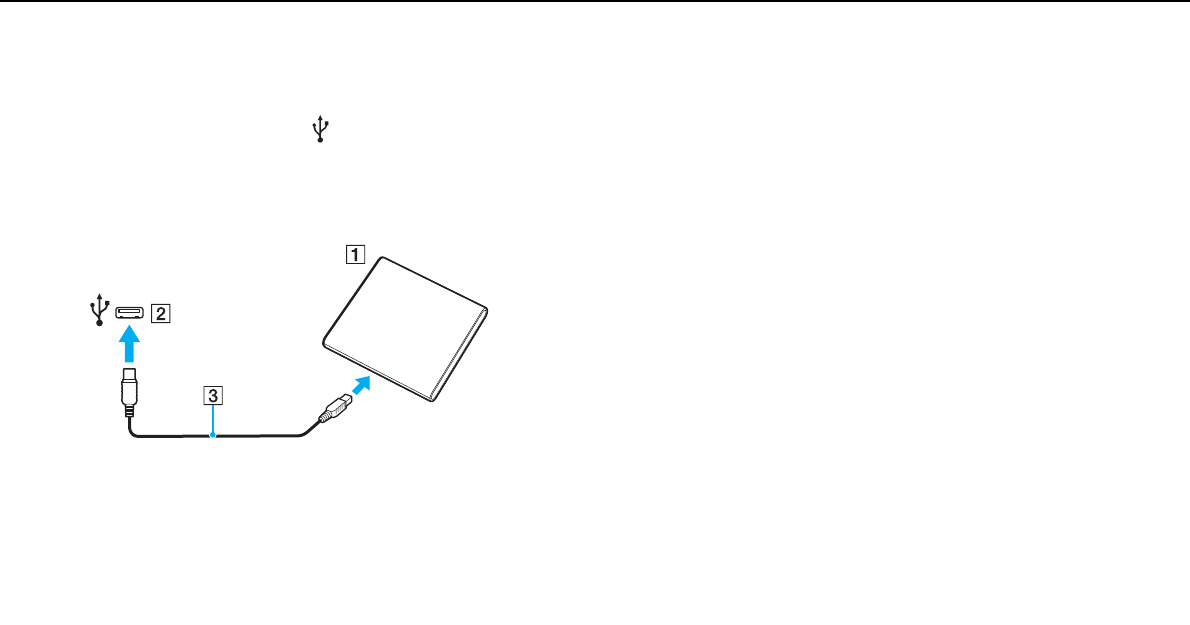
68
nN
Using Peripheral Devices >
Connecting an Optical Disc Drive
To connect an optical disc drive
1Plug the power cord (if any) of your external optical disc drive (1) into an AC outlet.
2Choose the USB port (2) you prefer to use.
3Plug one end of a USB cable (3) into the USB port, and the other end to the optical disc drive.
See the manual that came with your external optical disc drive for the detailed instructions on connecting the USB cable
to the drive.
Disconnecting an Optical Disc Drive
You can disconnect an optical disc drive while your computer is either on or off. Disconnecting the drive while the computer
is in a power saving mode (Sleep or Hibernate), however, may cause the computer to malfunction.
To disconnect an optical disc drive
✍
To disconnect an optical disc drive while your computer is off, skip steps 1 to 5.
1Close all software applications accessing the optical disc drive.
2Double-click the Safely Remove Hardware icon on the taskbar.
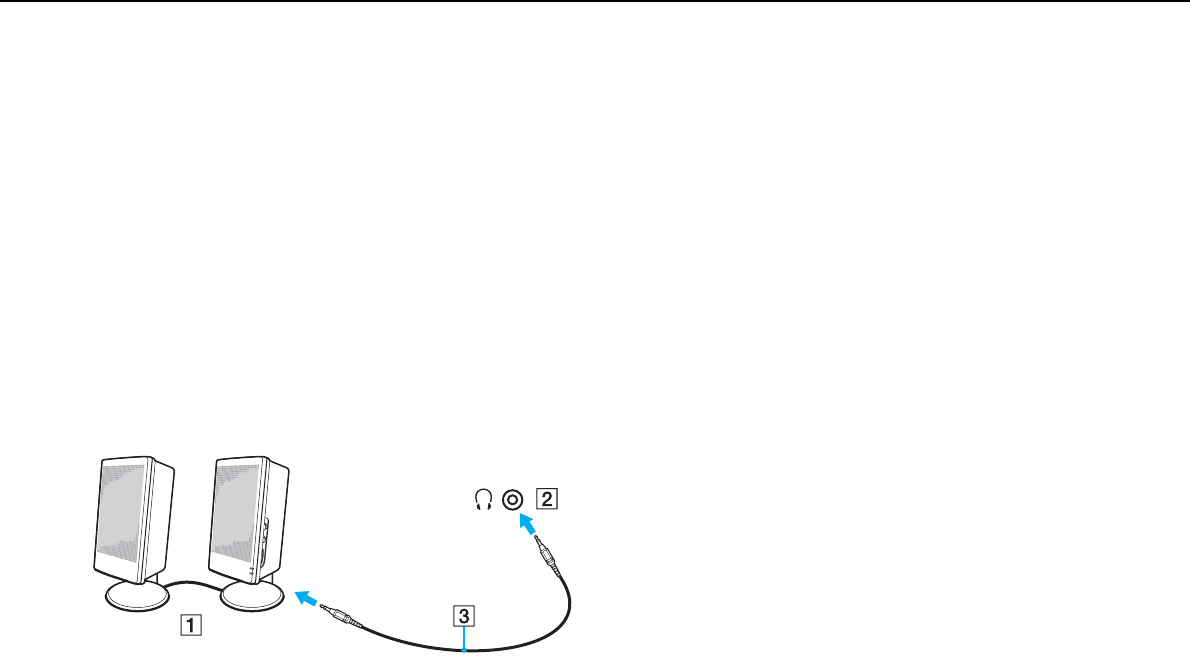
69
nN
Using Peripheral Devices >
Connecting External Speakers or Headphones
3Select the optical disc drive you want to disconnect.
4Click Stop.
5Follow the on-screen instructions for disconnecting the optical disc drive.
6Unplug the USB cable from the computer.
Connecting External Speakers or Headphones
You can connect external sound output devices (not supplied), such as speakers or headphones, to your computer.
To connect external speakers
✍
Make sure your speakers are designed for computer use.
!
Turn down the volume of the speakers before you turn them on.
Connect external speakers (1) to the headphones jack (2) i with a speaker cable (3) (not supplied).

70
nN
Using Peripheral Devices >
Connecting an External Display
Connecting an External Display
You can connect an external display (not supplied) to your computer. For example, you can use the computer with a computer
display or a projector.
Features and options in this section may not be available on your computer.
✍
Connect the power cord of your external display after connecting all other cables.
Connecting a Computer Display or a Projector
You can connect a computer display (analog monitor) or a projector to your computer.
To connect a computer display or a projector
Except IRX-4860_BGN
1If you want to connect a computer display (an analog monitor), plug one end of the display's power cord (1) into your
display if necessary, and the other end into an AC outlet.
2Plug the display cable (2) into the monitor port (3) a on the computer.
3If you want to connect a projector, plug the projector's power cord (4) into an AC outlet.
4Plug one end of the display cable (5) into the monitor port on the projector, and the other end into the monitor port (3) on
the computer.
5Plug one end of the speaker cable (6) into the headphones jack on the projector, and the other end into the headphones
jack (7) i on the computer.
Except IRX-4860_END
IRX-4860_BGN
1Unfold the tilt feet (page 21).
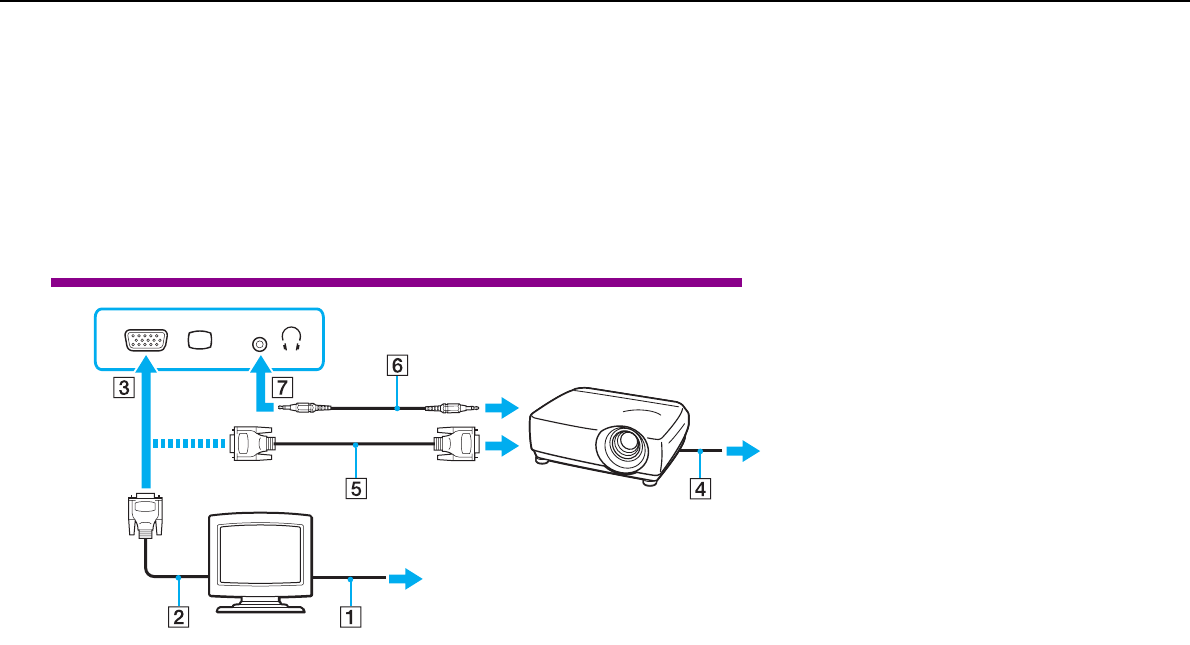
71
nN
Using Peripheral Devices >
Connecting an External Display
2If you want to connect a computer display (an analog monitor), plug one end of the display's power cord (1) into your
display if necessary, and the other end into an AC outlet.
3Plug the display cable (2) into the monitor port (3) a on the computer.
4If you want to connect a projector, plug the projector's power cord (4) into an AC outlet.
5Plug one end of the display cable (5) into the monitor port on the projector, and the other end into the monitor port (3) on
the computer.
6Plug one end of the speaker cable (6) into the headphones jack on the projector, and the other end into the headphones
jack (7) i on the computer.
IRX-4860_END

72
nN
Using Peripheral Devices >
Selecting Display Modes
Selecting Display Modes
When an external display is connected, you can select either your computer screen or the connected display to use as the
primary monitor.
If you want to work on your computer screen and the external display at the same time, see Using the Multiple Monitors
Function (page 73) for more information.
IRX-4860_BGN
!
You need to unfold the tilt feet before using the monitor port on your computer.
IRX-4860_END
✍
You may not be able to display the same contents on your computer screen and the external display or projector at the same time, depending on the
type of your external display or projector.
Turn on the external display before turning on your computer.
To select a display mode with the Fn+F7 keys
You can select a display mode with the Fn+F7 keys. See Combinations and Functions with the Fn Key (page 34) for the
detailed procedure.
To select a display mode from the display settings
1Right-click on the desktop and select Screen resolution.
2Click the drop-down list next to Multiple Displays, select your desired setting, and then click OK.

73
nN
Using Peripheral Devices >
Using the Multiple Monitors Function
Using the Multiple Monitors Function
The Multiple Monitors function allows you to distribute portions of your desktop across separate displays. For example, if you
have an external display connected to the monitor port, your computer screen and the external display can function as a
single desktop.
You can move the cursor from one display to the other. This allows you to drag objects, such as an open application window
or a toolbar, from one display to the other.
To use the Multiple Monitors function
IRX-4860_BGN
!
You need to unfold the tilt feet before using the monitor port on your computer.
IRX-4860_END

74
nN
Using Peripheral Devices >
Connecting a USB Device
✍
Your external display may not support the Multiple Monitors function.
Certain software applications may not be compatible with Multiple Monitors settings.
Make sure that your computer does not enter Sleep or Hibernate mode while you are using the Multiple Monitors function. Otherwise, the computer
may not return to Normal mode.
If you set different colors on each display, do not expand a single window across two displays. Otherwise, your software may not work properly.
Set fewer colors or a lower resolution for each display.
1Right-click on the desktop and select Screen resolution.
2Click the drop-down list next to Multiple Displays, select Extend these displays, and then click OK.
✍
Additionally, you can set the display colors and resolution for each display and customize the Multiple Monitors function.
Connecting a USB Device
You can connect a Universal Serial Bus (USB) device to your computer, such as a mouse, floppy disk drive, speaker, and
printer.
To connect a USB device
1Choose the USB port (1) you prefer to use.
2Plug the USB device cable (2) into the USB port.
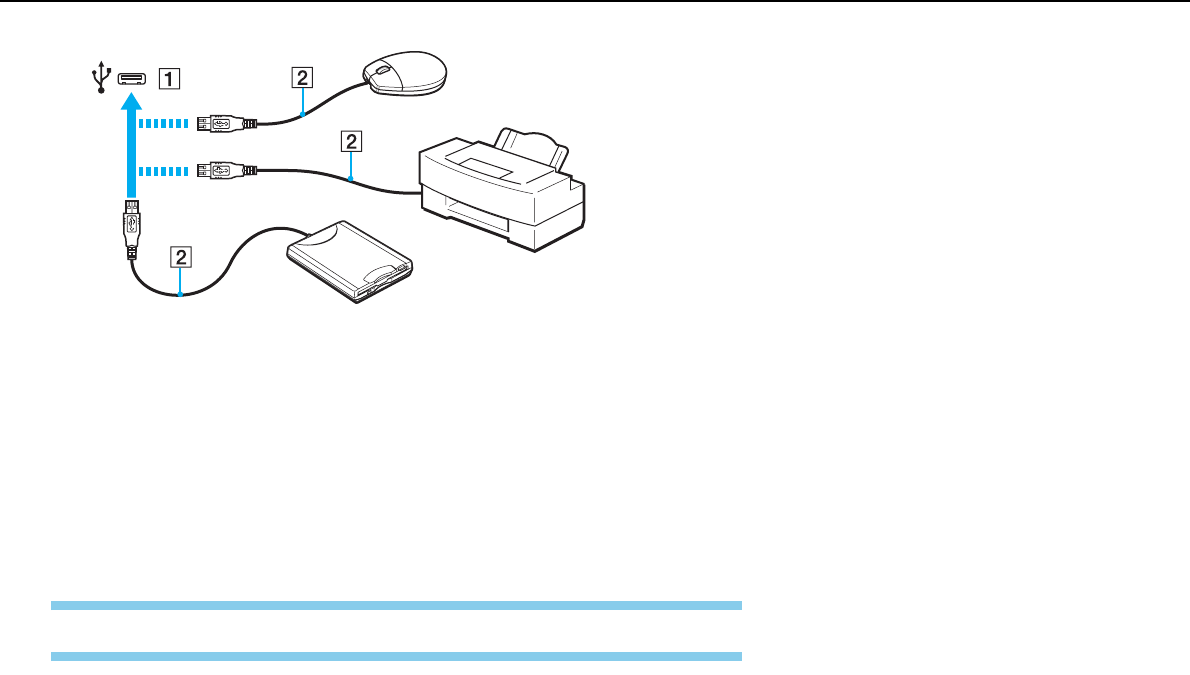
75
nN
Using Peripheral Devices >
Connecting a USB Device
Notes on connecting a USB device
❑You may need to install the driver software supplied with your USB device before use. See the manual that came with the
USB device for more information.
❑Be sure to use a USB printer compatible with your version of Windows to print documents.
❑For information on how to remove a USB device, see the manual that came with the device.
❑To protect your computer and/or USB devices from damage, observe the following:
❑When moving the computer with USB devices connected, avoid exposing the USB ports to shock or impact.
❑Do not put the computer into a bag or carrying case when it has USB devices connected.
GVD model_BGN
❑The optional USB floppy disk drive may not be available in some countries or regions.
GVD model_END

76
nN
Customizing Your VAIO Computer >
Setting the Password
Customizing Your VAIO Computer
This section briefly describes how to change the main settings of your VAIO computer. Among other things, you will learn
how to use and customize the look of your Sony software and utilities.
❑Setting the Password (page 76)
❑Using Intel VT (page 82)
❑Using the VAIO Control Center (page 83)
❑Using the VAIO Power Management (page 84)
Setting the Password
In addition to the Windows password, you can use BIOS functions to set two types of passwords to protect your computer:
the power-on password and the hard disk password.
Once you have set the power-on password, you will be prompted to enter the password after the VAIO logo appears to start
your computer. The power-on password allows you to protect your computer from unauthorized access.
The hard disk password provides additional security for the data stored on your built-in storage device. If you set the hard
disk password, other users will not be able to access the data without knowing the password, even if the password-protected
built-in storage device is removed from your computer and is installed in another computer.
Adding the Power-on Password
The power-on password is provided to protect your computer from unauthorized access.
There are two types of the power-on passwords: the machine password and the user password. The machine password is
provided for users with administrative rights on the computer to change all the setup options in the BIOS setup screen, as
well as to start the computer. The user password is provided for the standard users to allow for changing some of the BIOS
setup options, as well as starting the computer. To set the user password, you must first set the machine password.

77
nN
Customizing Your VAIO Computer >
Setting the Password
!
Once you have set the power-on password, you cannot start your computer without entering the password. Be sure not to forget the password. Write
down your password and keep it safe and private from other people.
If you forget the power-on password and need assistance to reset it, a password reset fee will be charged, and your computer may need to be sent in
for service to reset the password.
To add the power-on password (machine password)
1Turn on the computer.
2Press the F2 key when the VAIO logo appears.
The BIOS setup screen appears. If not, restart the computer and press the F2 key several times when the VAIO logo
appears.
3Press the < or , key to select Security to display the Security tab, select Set Machine Password, and then press the
Enter key.
4On the password entry screen, enter the password twice and press the Enter key.
The password can be up to 32 alphanumeric characters (including spaces) long.
5Select Password when Power On under Security and press the Enter key.
6Change the setting from Disabled to Enabled.
7Press the < or , key to select Exit, select Exit Setup, and then press the Enter key.
At the confirmation prompt, press the Enter key.
To add the power-on password (user password)
!
Make sure you set the machine password before setting the user password.
1Turn on the computer.

78
nN
Customizing Your VAIO Computer >
Setting the Password
2Press the F2 key when the VAIO logo appears.
The BIOS setup screen appears. If not, restart the computer and press the F2 key several times when the VAIO logo
appears.
3Enter the machine password and press the Enter key.
4Press the < or , key to select Security to display the Security tab, select Set User Password, and then press the
Enter key.
5On the password entry screen, enter the password twice and press the Enter key.
The password can be up to 32 alphanumeric characters (including spaces) long.
6Press the < or , key to select Exit, select Exit Setup, and then press the Enter key.
At the confirmation prompt, press the Enter key.
Changing/Removing the Power-on Password
To change or remove the power-on password (machine password)
1Turn on the computer.
2Press the F2 key when the VAIO logo appears.
The BIOS setup screen appears. If not, restart the computer and press the F2 key several times when the VAIO logo
appears.
3Enter the machine password and press the Enter key.
4Press the < or , key to select Security to display the Security tab, select Set Machine Password, and then press the
Enter key.
5On the password entry screen, enter the current password once and a new password twice, and then press the Enter key.
To remove the password, leave the Enter New Password and Confirm New Password fields blank and press the Enter
key.

79
nN
Customizing Your VAIO Computer >
Setting the Password
6Press the < or , key to select Exit, select Exit Setup, and then press the Enter key.
At the confirmation prompt, press the Enter key.
To change or remove the power-on password (user password)
1Turn on the computer.
2Press the F2 key when the VAIO logo appears.
The BIOS setup screen appears. If not, restart the computer and press the F2 key several times when the VAIO logo
appears.
3Enter the user password and press the Enter key.
4Press the < or , key to select Security to display the Security tab, select Set User Password, and then press the
Enter key.
5On the password entry screen, enter the current password once and a new password twice, and then press the Enter key.
To remove the password, leave the Enter New Password and Confirm New Password fields blank and press the Enter
key.
6Press the < or , key to select Exit, select Exit Setup, and then press the Enter key.
At the confirmation prompt, press the Enter key.
Adding the Hard Disk Password
The hard disk password provides additional security for the data stored on your built-in storage device. If you enable the hard
disk password, this adds an extra level of security.
When adding the hard disk password, you must set both the master and user passwords. The master password is provided
for users with administrative rights on the computer to reset the user password in the BIOS setup screen. The user password
is provided to lock your built-in storage device. Once you set the user password, you will have to enter the password along
with the power-on password (if set), after the VAIO logo appears.

80
nN
Customizing Your VAIO Computer >
Setting the Password
!
You cannot start your computer with the master password.
If you forget the master password or the keyboard fails, which is critical to password entry, no bypass is possible and the data stored on the built-in
storage device will not be accessible. There is NO RESET of this password. You will have to replace the built-in storage device at your own expense and
lose all the data originally stored on the device. Be sure to write down the master password and keep it safe and private from other people.
Except IRX-4860_BGN
✍
If you have set the hard disk password in conjunction with the fingerprint authentication function, you can substitute fingerprint authentication for
password entry when turning on your computer. For more information, see Using Fingerprint Authentication .
Except IRX-4860_END
To add the hard disk password
1Turn on the computer.
2Press the F2 key when the VAIO logo appears.
The BIOS setup screen appears. If not, restart the computer and press the F2 key several times when the VAIO logo
appears.
✍
If you have set the power-on password, enter your power-on password.
3Press the < or , key to select Security to display the Security tab, select Hard Disk Password, and then press the
Enter key.
The Hard Disk Password entry screen appears.
4Select Enter Master and User Passwords and press the Enter key.
5Select Continue on the warning screen and press the Enter key.
6Enter the master password twice and press the Enter key.
The password should be up to 32 alphanumeric characters (including spaces) long.

81
nN
Customizing Your VAIO Computer >
Setting the Password
7Enter the user password twice and press the Enter key.
The password should be up to 32 alphanumeric characters (including spaces) long.
8At the confirmation prompt, press the Enter key.
9Press the Esc key and then the < or , key to select the Exit tab.
10 Press the M or m key to select Exit Setup and press the Enter key.
At the confirmation prompt, press the Enter key.
Changing/Removing the Hard Disk Password
To change the hard disk password
1Turn on the computer.
2Press the F2 key when the VAIO logo appears.
The BIOS setup screen appears. If not, restart the computer and press the F2 key several times when the VAIO logo
appears.
✍
If you have set the power-on password, enter your power-on password.
3Press the < or , key to select Security to display the Security tab, select Hard Disk Password, and then press the
Enter key.
The Hard Disk Password entry screen appears.
4Select Change Master Password or Change User Password and press the Enter key.
5Enter the current password once and then a new password twice.
6Press the Enter key.
7Press the Enter key when the success message appears.
8Press the Esc key and then the < or , key to select the Exit tab.

82
nN
Customizing Your VAIO Computer >
Using Intel VT
9Press the M or m key to select Exit Setup and press the Enter key.
At the confirmation prompt, press the Enter key.
To remove the hard disk password
1Turn on the computer.
2Press the F2 key when the VAIO logo appears.
The BIOS setup screen appears. If not, restart the computer and press the F2 key several times when the VAIO logo
appears.
✍
If you have set the power-on password, enter your power-on password.
3Press the < or , key to select Security to display the Security tab, select Hard Disk Password, and then press the
Enter key.
The Hard Disk Password entry screen appears.
4Select Enter Master and User Passwords and press the Enter key.
5Enter the current password for Enter Current Hard Disk Master Password and press the Enter key.
6Press the Enter key without entering any letter for the remaining fields.
7Press the Enter key when the success message appears.
8Press the Esc key and then the < or , key to select the Exit tab.
9Press the M or m key to select Exit Setup and press the Enter key.
At the confirmation prompt, press the Enter key.
Using Intel VT
Intel® Virtualization Technology (VT) allows you to use hardware virtualization software for enhancing your computer's
performance.

83
nN
Customizing Your VAIO Computer >
Using the VAIO Control Center
!
For information on virtualization and how to use hardware virtualization software, contact the software publisher.
Intel VT may not be available depending on the CPU installed on your computer.
To enable Intel VT
1Turn on your computer.
2Press the F2 key when the VAIO logo appears.
The BIOS setup screen appears. If not, restart the computer and press the F2 key several times when the VAIO logo
appears.
3Press the < or , key to select Advanced.
4Press the M or m key to select Intel(R) Virtualization Technology or Intel(R) VT, press the Enter key, select Enabled,
and press the Enter key.
!
If the Advanced tab is not displayed in the BIOS setup window or you cannot select Intel(R) Virtualization Technology, Intel VT is not available on the
computer.
5Press the < or , key to select Exit, select Exit Setup, and then press the Enter key.
At the confirmation prompt, press the Enter key.
Using the VAIO Control Center
The VAIO Control Center utility allows you to access system information and to specify preferences for system behavior.
To use the VAIO Control Center
1Click Start, All Programs, and VAIO Control Center.
2Select your desired control item and change the settings.

84
nN
Customizing Your VAIO Computer >
Using the VAIO Power Management
3Once finished, click OK.
The setting of the desired item has been changed.
✍
For more information about each option, see the help file included with the VAIO Control Center.
Some of the control items will not be visible if you open the VAIO Control Center as a standard user.
Using the VAIO Power Management
Power management helps you set up power plans for running on AC or battery power to suit your requirements for power
consumption.
The VAIO Power Management function is added to the Windows Power Options. With this software application, you can
enhance the Windows power management functions to ensure better operation of your computer and longer battery life.
Selecting a Power Plan
When you start the computer, a power status icon appears on the taskbar. This icon indicates what kind of power source you
are using at that time, for example, AC power. Click this icon to display the window that shows your power status.
To select a power plan
1Right-click the power status icon on the taskbar and select Power Options.
2Select your desired power plan.
To change the power plan settings
1Click Change plan settings on the right of your desired power plan in the Power Options window.
Change the Sleep mode and display settings as needed.
2If you need to change the advanced settings, click Change advanced power settings and go to step 3.
Otherwise, click Save changes.

86
nN
Precautions >
Safety Information
Precautions
This section describes safety guidelines and precautions to help you protect your VAIO computer from potential damage.
❑Safety Information (page 86)
❑Care and Maintenance Information (page 90)
❑Handling Your Computer (page 91)
❑Handling the LCD Screen (page 93)
❑Using the Power Source (page 94)
❑Handling the Built-in Camera (page 95)
❑Handling Discs (page 95)
❑Using the Battery Pack (page 96)
❑Handling "Memory Stick" (page 97)
❑Handling the Built-in Storage Device (page 97)
Safety Information
Computer
❑Use your computer on a solid, stable surface.
Except China_BGN
Except Euro_BGN
❑Provide adequate air circulation to prevent internal overheating. Do not place your computer on porous surfaces such as
rugs, blankets, couches, or beds, or near draperies that may block its air vents.

87
nN
Precautions >
Safety Information
❑Do not use your computer directly on your lap. The temperature of the base of the unit will rise during normal operation
and over time could result in discomfort or burns.
Except Euro_END
Except China_END
China model_BGN
❑Provide adequate air circulation to prevent internal overheating. Do not place your computer on porous surfaces such as
rugs, blankets, couches, or beds, or near draperies that may block its air vents.
❑Do not use your computer on your lap for an extended period of time. Use of your computer for an extended period of time
will heat up the bottom of the computer and may cause low-temperature burns.
China model_END
Euro model_BGN
❑We advise not to use your computer directly on your lap. The temperature of the bottom of the unit may rise during normal
operation, and after an extended period of time, could cause discomfort or burns.
❑Provide adequate air circulation to prevent internal overheating. Do not place your computer on porous surfaces such as
rugs, blankets, couches, or beds, or near draperies that may block its air vents.
Euro model_END
❑Use only specified peripheral equipment and interface cables. Otherwise, problems may occur.
Power Source
❑Do not place heavy objects on the power cord. Doing so may cause fire.
❑To disconnect the cord, pull it out by holding the plug. Never pull the cord itself.
❑Unplug your computer from the AC outlet if you are not planning to use the computer for a long period of time.
❑When the AC adapter is not used, unplug it from the AC outlet.

88
nN
Precautions >
Safety Information
❑Make sure that the AC outlet is easily accessible.
Battery Pack
US model_BGN
❑Do not leave battery packs in temperatures above 140°F (60°C), such as in a car parked in the sun or under direct
sunlight.
US model_END
Except US model_BGN
❑Do not leave battery packs in temperatures above 60°C, such as in a car parked in the sun or under direct sunlight.
Except US model_END
US model_BGN
❑For your safety, Sony recommends using the genuine Sony battery pack and AC adapter that are provided with this
product. If either of these items needs to be replaced during the life of the product, be sure to use a compatible genuine
Sony battery pack or AC adapter. Information about compatible models can be found at the following URLs:
❑For customers in USA and Canada
http://www.sony.com/vaio
❑For customers in Latin American countries or areas
http://www.sony.net/
❑Sony disclaims and shall assume no responsibility in case of any losses or damages arising from:
❑The use of non-genuine Sony battery packs or AC adapters with your VAIO computer.
❑The disassembly, alteration of, or tampering with any Sony battery pack.
US model_END
China model_BGN

89
nN
Precautions >
Safety Information
❑For your safety, Sony recommends using the genuine Sony battery pack and AC adapter that are provided with this
product.
❑Sony disclaims and shall assume no responsibility in case of any losses or damages arising from:
❑The use of non-genuine Sony battery packs or AC adapters with your VAIO computer.
❑The disassembly, alteration of, or tampering with any Sony battery pack.
China model_END
Euro model_BGN
❑Certain rechargeable battery packs do not meet Sony quality and safety standards. For safety reasons this computer only
functions with genuine Sony battery packs designed for this model. If an unauthorized battery pack is installed, the battery
pack will not be charged and the computer will not function.
Euro model_END
GVD model_BGN
❑For your safety, it is highly recommended that you use genuine Sony rechargeable battery packs and AC adapters that
meet the quality assurance standard, supplied by Sony for your VAIO computer. Some VAIO computers may only function
with a genuine Sony battery pack.
GVD model_END
❑Keep the battery pack away from all sources of heat.
❑Keep the battery pack dry.
❑Do not open or try to disassemble the battery pack.
❑Do not expose the battery pack to any mechanical shock, such as dropping it on a hard surface.
❑If you are not using your computer for a long period of time, remove the battery pack from the computer to prevent damage
to the battery pack.

90
nN
Precautions >
Care and Maintenance Information
❑If you have not used the battery pack for a considerable amount of time, the remaining battery life may become short.
However, this is normal and does not indicate a malfunction, because the battery pack will gradually discharge over time
even while not in use. Connect the AC adapter to your computer and recharge the battery pack before using the computer
again.
Headphones
❑Road safety – Do not use headphones while driving, cycling, or operating any motorized vehicle. It may create a traffic
hazard and is illegal in some areas. It can also be potentially dangerous to play loud music while walking, especially at
pedestrian crossings.
❑Preventing hearing damage – Avoid using headphones at high volume. Hearing experts advise against continuous, loud
and extended play. If you experience a ringing in your ears, reduce the volume or discontinue use.
"Memory Stick"
Keep "Memory Stick" and "Memory Stick" adaptors out of reach of children. There is a risk of swallowing them.
Care and Maintenance Information
Computer
❑Clean the cabinet with a soft cloth, which is dry or lightly moistened with a mild detergent solution. Do not use any type
of abrasive pad, scouring powder, or solvent such as alcohol or benzine, as these may damage the finish of your
computer.
❑Make sure you unplug the AC adapter and remove the battery pack before cleaning your computer.
LCD Screen
Use a soft, dry cloth to wipe the surface of the LCD screen. Rubbing the surface could damage the screen.

91
nN
Precautions >
Handling Your Computer
Built-in Camera
Clean the lens protection cover of the built-in camera with a blower brush or a soft brush. If the cover is extremely dirty, wipe
it off with a soft dry cloth. Do not rub the cover, as it is sensitive to pressure.
Discs
❑Proper care of the disc is essential to its continuous reliability. Do not use solvents (such as benzine, thinner, alcohol,
commercially available cleaners, or anti-static spray) which may cause damage to the disc.
❑For normal cleaning, hold the disc by its edges and use a soft cloth to wipe the surface from the center out.
❑If the disc is badly soiled, moisten a soft cloth with water, wring it out well, and use it to wipe the surface of the disc from
the center out. Wipe off any remaining moisture with a dry soft cloth.
Handling Your Computer
❑If you drop a solid object or any liquid onto your computer, shut down the computer, unplug it, and remove the battery
pack. You may want to have the computer checked by qualified personnel before operating it again.
❑Do not drop your computer or place any objects on top of the computer.
❑Do not place your computer in a location subject to:
❑Heat sources, such as radiators or air ducts
❑Direct sunlight
❑Excessive dust
❑Moisture or rain
❑Mechanical vibration or shock
❑Strong magnets or speakers that are not magnetically shielded

92
nN
Precautions >
Handling Your Computer
US model_BGN
❑Ambient temperature of more than 95°F (35°C) or less than 41°F (5°C)
US model_END
Except US model_BGN
❑Ambient temperature of more than 35°C or less than 5°C
Except US model_END
❑High humidity
❑Do not place electronic equipment near your computer. The electromagnetic field of the equipment may cause the
computer to malfunction.
IRX-4860_BGN
❑Do not use your computer without the battery pack installed as it may cause the computer to malfunction.
IRX-4860_END
❑Your computer uses high-frequency radio signals and may cause interference to radio or TV reception. If this occurs,
relocate the computer a suitable distance away from the set.
❑Do not use cut or damaged connection cables.
US model_BGN
❑If your computer is brought directly from a cold location to a warm one, moisture may condense inside the computer. In
such a case, allow at least one hour before turning on the computer. If any problems occur, unplug the computer and
contact an authorized Sony Service Center. To find the nearest center or agent, see Finding More about Your VAIO
Computer (page 6).
US model_END
Except US model_BGN
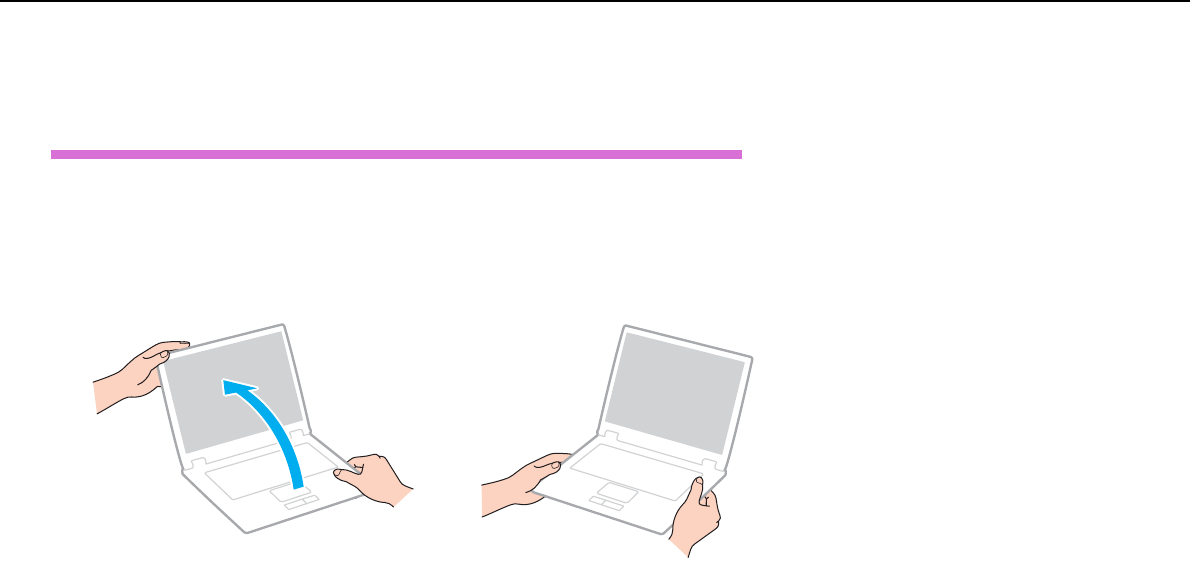
93
nN
Precautions >
Handling the LCD Screen
❑If your computer is brought directly from a cold location to a warm one, moisture may condense inside the computer. In
such a case, allow at least one hour before turning on the computer. If any problems occur, unplug the computer and
contact VAIO HelpdeskVAIO-LinkVAIO HelpdeskSony Computing SupportVAIO-LinkVAIO HelpdeskSony Computing
Support.
Except US model_END
❑To avoid losing data when your computer is damaged, back up your data regularly.
❑Do not exert pressure on the LCD screen or its edges when opening the LCD screen lid or lifting your computer. The LCD
screen may be sensitive to pressure or added stress, and exerting pressure may damage the screen or cause it to
malfunction. To open the computer, hold the base with one hand and gently lift the LCD screen lid with the other. To carry
the computer with the lid open, be sure to hold the computer with both hands.
❑Use a carrying case specially designed to carry your computer.
Handling the LCD Screen
❑Do not leave the LCD screen facing the sun. This could damage the LCD screen. Be sure to block direct sunlight when
using your computer near a window.

94
nN
Precautions >
Using the Power Source
❑Do not scratch the surface of the LCD screen or exert pressure on it. This could cause a damage.
❑Using your computer in low temperature conditions may produce a residual image on the LCD screen. This is not a
malfunction. When the computer returns to normal temperature, the screen returns to normal.
❑A residual image may appear on the LCD screen if the same image is displayed for a long period of time. The residual
image disappears after a while. You can use a screen saver to prevent residual images.
❑The LCD screen becomes warm during operation. This is normal and does not indicate a malfunction.
❑The LCD screen is manufactured using high-precision technology. You may, however, see tiny black points and/or bright
points (red, blue, or green) that continuously appear on the LCD screen. This is a normal result of the manufacturing
process and does not indicate a malfunction.
❑Do not change the LCD screen orientation setting in the Tablet PC Settings window even when there are change options
available for selection, as this may make your computer unstable. Sony assumes no liability for any malfunctions arising
from changes to the settings.
❑Do not exert pressure on the LCD screen lid with the lid closed as it may scratch the LCD screen or soil it.
Using the Power Source
See the specifications to find out about the configuration of your computer.
❑Do not share the AC outlet with other power-consuming equipment, such as a photocopier or a shredder.
❑You can purchase a power strip with a surge protector. This device helps prevent damage to your computer caused by
sudden power surges, in an electrical storm, for example.
❑Use the AC adapter supplied with your computer or genuine Sony products. Do not use any other AC adapter as it may
cause a malfunction.
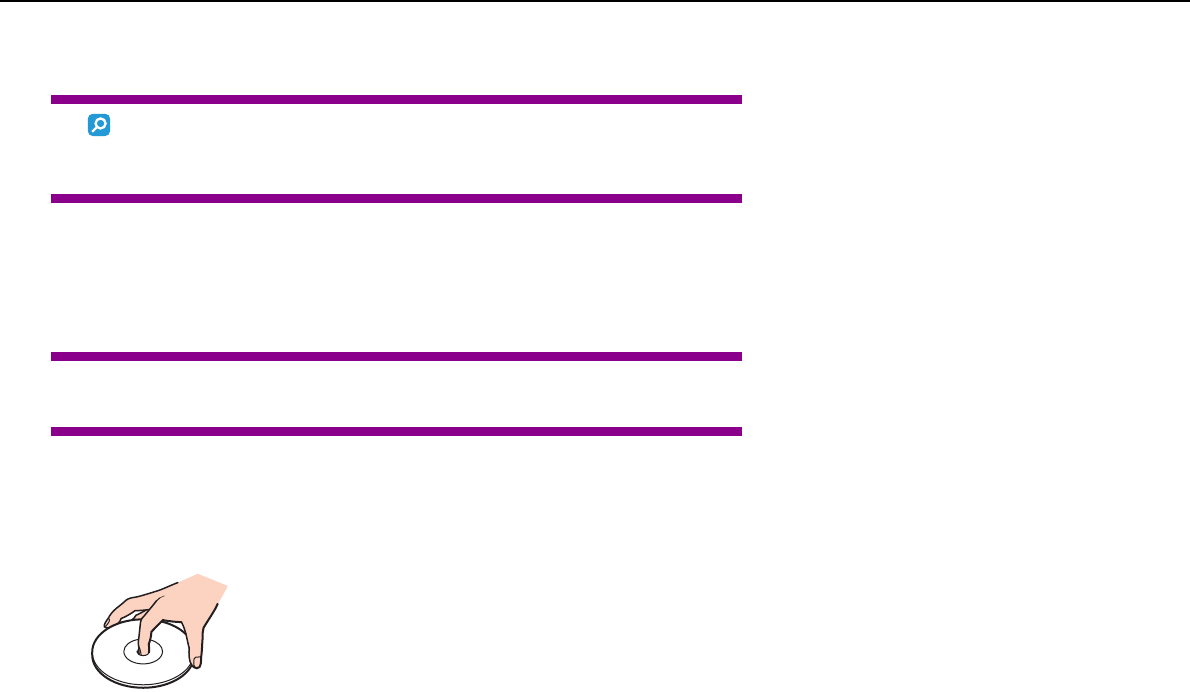
95
nN
Precautions >
Handling the Built-in Camera
Handling the Built-in Camera
Except IRX-4860_BGN
Features and options in this section may not be available on your computer.
See the specifications to find out about the configuration of your computer.
Except IRX-4860_END
❑Do not touch the lens protection cover of the built-in camera, as it may cause scratches on the cover and such scratches
will appear on the captured images.
❑Do not let the direct sunlight get into the lens of the built-in camera regardless of your computer's power state, as it may
cause the camera to malfunction.
Except IRX-4860_BGN
❑The built-in camera is disabled while videos or still images are imported from an i.LINK-compatible device connected to
the i.LINK port.
Except IRX-4860_END
Handling Discs
❑Fingerprints and dust on the surface of a disc may cause read errors. Be sure to hold the disc by its edges and central
hole, as shown below:
❑Never affix an adhesive label to a disc. This will affect the use of the disc and may result in irreparable damage.

96
nN
Precautions >
Using the Battery Pack
Using the Battery Pack
❑Battery life is shorter in a cold environment. This is due to decreased battery efficiency at low temperatures.
US model_BGN
❑Charge battery packs at temperatures between 50°F to 86°F (10°C to 30°C). Lower temperatures require longer charging
time.
US model_END
Except US model_BGN
❑Charge battery packs at temperatures between 10°C to 30°C. Lower temperatures require longer charging time.
Except US model_END
US model_BGN
❑Do not charge the battery pack in any way other than as described in this user guide or as designated by Sony in writing.
US model_END
China model_BGN
❑Do not charge the battery pack in any way other than as described in this user guide or as designated by Sony in writing.
China model_END
❑While the battery pack is in use or being charged, heat builds up in the battery pack. This is normal and is not cause for
concern.
❑You do not need to discharge the battery pack before recharging.
❑If the battery pack quickly runs out of power after being fully charged, it may be reaching the end of its life and should be
replaced.

97
nN
Precautions >
Handling "Memory Stick"
Handling "Memory Stick"
❑Do not touch the "Memory Stick" connector with your finger or metallic objects.
❑Use only the adhesive label supplied with "Memory Stick" as a label.
❑Do not bend, drop, or expose "Memory Stick".
❑Do not disassemble or modify "Memory Stick".
❑Do not let "Memory Stick" get wet.
❑Do not use or store "Memory Stick" in a location subject to:
❑Static electricity
❑Electrical noise
❑Extremely high temperatures, such as in a car parked in the sun
❑Direct sunlight
❑High humidity
❑Corrosive substances
❑Use the storage case supplied with "Memory Stick".
❑Be sure to make a backup copy of your valuable data.
❑When using "Memory Stick Duo", do not use a fine-tipped pen to write on the label adhered to "Memory Stick Duo".
Exerting pressure on the media may damage internal components.
Handling the Built-in Storage Device
The built-in storage device (hard disk drive or solid state drive) has a high storage density and reads or writes data in a short
time. However, it can be easily damaged if improperly used. If the built-in storage device is damaged, the data cannot be
restored. To prevent losing data, you should be careful when handling your computer.

98
nN
Precautions >
Handling the Built-in Storage Device
Features and options in this section may not be available on your computer.
See the specifications to find out about the configuration of your computer.
To avoid damaging your hard disk drive
❑Do not subject your computer to sudden movements.
❑Keep your computer away from magnets.
❑Do not place your computer in a location subject to mechanical vibration or in an unstable position.
❑Do not move your computer while the power is on.
❑Do not turn off the power or restart your computer while reading or writing data to the hard disk drive.
❑Do not use your computer in a place subject to extreme changes in temperature.
China model_BGN
❑Do not use your computer in a place at 3,000 meters or higher above sea level. The hard disk drive may not work properly
under such an environment due to low air pressure.
China model_END
❑Do not remove the hard disk drive from your computer.
To avoid damaging your solid state drive
❑Do not turn off the power or restart your computer while reading or writing data to the solid state drive.
❑Do not remove the solid state drive from your computer.

99
nN
Troubleshooting >
Troubleshooting
US model_BGN
This section describes how to solve common problems you might encounter when using your VAIO computer. Many problems
have simple solutions. Try these suggestions before visiting the Sony online support web site
at the following URLs:
❑For customers in USA
http://esupport.sony.com/EN/VAIO/
❑For customers in Canada
http://www.sony.ca/support/
❑For customers in Spanish-speaking Latin American countries or areas
http://esupport.sony.com/LA/
❑For customers in Brazil
http://esupport.sony.com/BR/
US model_END
Except US model_BGN
This section describes how to solve common problems you might encounter when using your VAIO computer. Many problems
have simple solutions. Try these suggestions before contacting VAIO HelpdeskVAIO-LinkVAIO HelpdeskSony Computing
SupportVAIO-LinkVAIO HelpdeskSony Computing Support.
Except US model_END
Features and options in this section may not be available on your computer.
❑Computer (page 100)
❑System Security (page 109)

100
nN
Troubleshooting >
Computer
❑Battery (page 110)
❑Built-in Camera (page 111)
❑Networking (page 113)
❑Bluetooth Technology (page 117)
Euro model_BGN
❑GPS (page 121)
Euro model_END
❑Display (page 122)
❑Printing (page 125)
❑Speakers (page 125)
❑Touch Pad (page 127)
❑Keyboard (page 128)
❑Floppy Disks (page 128)
❑Audio/Video (page 129)
❑Memory Cards (page 131)
❑Peripherals (page 132)
Computer
What should I do if my computer does not start?
❑Make sure your computer is securely plugged into a power source and turned on and the power indicator light is lit.
❑Make sure the battery pack is installed properly and charged.

101
nN
Troubleshooting >
Computer
❑Disconnect all connected USB devices (if any), and then restart your computer.
Except IRX-4860_BGN
❑Remove any extra memory modules you may have installed since purchase, and then restart your computer.
Except IRX-4860_END
❑If your computer is plugged into a power strip or an uninterruptible power supply (UPS), make sure the power strip or UPS
is plugged into a power source and turned on.
❑If you are using an external display, make sure it is plugged into a power source and turned on. Make sure the brightness
and contrast controls are adjusted correctly. See the manual that came with your display for more information.
❑Unplug the AC adapter and remove the battery pack. Wait three to five minutes. Reinstall the battery pack, plug the AC
adapter, and then press the power button to turn on your computer.
❑Condensation may cause your computer to malfunction. If this occurs, do not use the computer for at least one hour.
❑Check that you are using the supplied Sony AC adapter. For your safety, use only the genuine Sony rechargeable battery
pack and AC adapter, which are supplied by Sony for your VAIO computer.
What should I do if the green power indicator light turns on but my screen remains blank?
❑Press the Alt+F4 keys several times to close the application window. An application error may have occurred.
❑If the Alt+F4 keys do not work, click Start, the arrow next to the Shut down button, and Restart to restart your computer.
❑If your computer does not restart, press the Ctrl+Alt+Delete keys and click the arrow next to the Shut down
button and Restart.
If the Windows Security window appears, click Restart.
❑If this procedure does not work, press and hold the power button for more than four seconds to shut down your computer.
Unplug the AC adapter and leave the computer for about five minutes. Then plug the AC adapter and turn on the computer
again.

102
nN
Troubleshooting >
Computer
!
Turning off your computer with the Ctrl+Alt+Delete keys or the power button may cause loss of unsaved data.
What should I do if my computer or software stops responding?
❑If your computer stops responding while a software application is running, press the Alt+F4 keys to close the application
window.
❑If the Alt+F4 keys do not work, click Start and the Shut down button to turn off your computer.
❑If your computer does not turn off, press the Ctrl+Alt+Delete keys and click the Shut down button.
If the Windows Security window appears, click Shut Down.
❑If this procedure does not work, press and hold the power button until the computer turns off.
!
Turning off your computer with the Ctrl+Alt+Delete keys or the power button may cause loss of unsaved data.
❑Unplug the AC adapter and remove the battery pack. Wait three to five minutes. Reinstall the battery pack, plug the AC
adapter, and then press the power button to turn on your computer.
❑Try reinstalling the software.
❑Contact the software publisher or designated provider for technical support.
Why doesn't my computer enter Sleep or Hibernate mode?
Your computer may become unstable if the operating mode is changed before the computer completely enters Sleep or
Hibernate mode.
To restore your computer to Normal mode
1Close all open programs.
2Click Start, the arrow next to the Shut down button, and Restart.

103
nN
Troubleshooting >
Computer
3If your computer does not restart, press the Ctrl+Alt+Delete keys and click the arrow next to the Shut down button and
Restart.
If the Windows Security window appears, click Restart.
4If this procedure does not work, press and hold the power button until the computer turns off.
!
Turning off your computer with the Ctrl+Alt+Delete keys or the power button may cause loss of unsaved data.
What should I do if the charge indicator light is blinking fast and my computer does not
start?
❑This problem could be due to the battery pack not being installed properly. To resolve this problem, turn off your computer
and remove the battery pack. Then reinstall the battery pack to the computer. For details, see Installing/Removing the
Battery Pack (page 25).
US model_BGN
❑If the problem persists after performing the above, it means the installed battery pack is not compatible. Remove the
battery pack and contact an authorized Sony Service Center. To find the nearest center or agent, see Finding More
about Your VAIO Computer (page 6).
US model_END
Except US model_BGN
❑If the problem persists after performing the above, it means the installed battery pack is not compatible. Remove the
battery pack and contact VAIO HelpdeskVAIO-LinkVAIO HelpdeskSony Computing SupportVAIO-LinkVAIO
HelpdeskSony Computing Support.
Except US model_END

104
nN
Troubleshooting >
Computer
What should I do if a message appears notifying of either incompatibility or the improper
installation of the battery pack and my computer then enters Hibernate mode?
❑This problem could be due to the battery pack not being installed properly. To resolve this problem, turn off your computer
and remove the battery pack. Then reinstall the battery pack to the computer. For details, see Installing/Removing the
Battery Pack (page 25).
US model_BGN
❑If the problem persists after performing the above, it means the installed battery pack is not compatible. Remove the
battery pack and contact an authorized Sony Service Center. To find the nearest center or agent, see Finding More
about Your VAIO Computer (page 6).
US model_END
Except US model_BGN
❑If the problem persists after performing the above, it means the installed battery pack is not compatible. Remove the
battery pack and contact VAIO HelpdeskVAIO-LinkVAIO HelpdeskSony Computing SupportVAIO-LinkVAIO
HelpdeskSony Computing Support.
Except US model_END
Why does the System Properties window display a slower CPU speed than the
maximum?
This is normal. Because your computer's CPU utilizes a type of CPU speed controlling technology for power conservation
purposes, System Properties may display the current CPU speed instead of the maximum speed.

105
nN
Troubleshooting >
Computer
What should I do if my computer does not accept my password and returns a message,
Enter Onetime Password?
If you enter a wrong power-on password three times consecutively, the Enter Onetime Password message appears and
Windows will not start. Press and hold the power button for more than four seconds to check that the power indicator light
turns off. Wait for 10 or 15 seconds, then restart your computer and enter the correct password. When entering the password,
check that the Num lock and Caps lock indicator lights are unlit. If both or either of the lights is lit, press the Num Lk (or Num
Lock) key or the Caps Lock key to turn off the indicator light before entering the password.
What should I do if my game software does not work or it keeps crashing?
❑Check the web site of the game if there are any patches or updates to download.
❑Make sure you have installed the latest video driver software.
❑On some VAIO models, the graphics memory is shared with the system. The optimal graphic performance in such a case
is not guaranteed.
What should I do if I cannot remember the power-on password?
US model_BGN
If you have forgotten the power-on password, contact an authorized Sony Service Center to reset it. A reset fee will be
charged. To find the nearest center or agent, see Finding More about Your VAIO Computer (page 6).
US model_END
Except US model_BGN
If you have forgotten the power-on password, contact VAIO HelpdeskVAIO-LinkVAIO HelpdeskSony Computing
SupportVAIO-LinkVAIO HelpdeskSony Computing Support to reset it. A reset fee will be charged.
Except US model_END

106
nN
Troubleshooting >
Computer
How can I change the boot device order?
You can use one of the BIOS functions to change the boot device order. Follow these steps:
1Turn on your computer.
2Press the F2 key when the VAIO logo appears.
The BIOS setup screen appears. If not, restart the computer and press the F2 key several times when the VAIO logo
appears.
3Press the < or , key to select Boot.
IRX-4860_BGN
4Press the M or m key to select the drive whose boot device order you want to change.
5Press the F5 or F6 key to change the boot device order.
IRX-4860_END
Except IRX-4860_BGN
6Press the M or m key to select your desired priority under Boot Priority and press the Enter key.
7Press the M or m key to select the device to which you want to assign the priority and press the Enter key.
Except IRX-4860_END
8Press the < or , key to select Exit, select Exit Setup, and then press the Enter key.
At the confirmation prompt, press the Enter key.
Why doesn't my screen turn off after the automatic turn-off time has passed?
The VAIO original screen saver disables the timer setting, which you can select using the Windows power options, for your
screen to turn off.
Select a screen saver other than the VAIO original screen saver.

107
nN
Troubleshooting >
Computer
What should I do if I cannot boot my computer from the external device connected to the
computer?
Except IRX-4860_BGN
To boot your computer from the external device, for example the USB floppy disk drive or the USB/i.LINK optical disc drive,
you need to change the boot device.
Except IRX-4860_END
IRX-4860_BGN
To boot your computer from the external device, for example the USB floppy disk drive or the USB optical disc drive, you
need to change the boot device.
IRX-4860_END
Turn on your computer and press the F11 key when the VAIO logo appears.
How do I reduce the volume of the recovery partition?
Your built-in storage device contains the recovery partition where the data for the system recovery is stored. If your computer
includes a solid state drive, you might want to reduce the volume of the recovery partition by following these steps:
Except IRX-4860_BGN
1Insert a recovery disc into the optical disc drive while your computer is on, turn off the computer, and then turn it on once
again.
Except IRX-4860_END
IRX-4860_BGN
1Insert a recovery disc into an external optical disc drive (not supplied) while your computer is on, turn off the computer,
and then turn it on once again.
2Press the F11 key when the VAIO logo appears during the startup process.

108
nN
Troubleshooting >
Computer
IRX-4860_END
!
Use recovery disc(s) you created upon delivery of your computer.
3Select your keyboard layout from the drop-down list and click Next.
4Select your operating system and click Next.
5Click VAIO Recovery Center.
6Click Restore Complete System and Start.
7Select Skip and click Next.
You will be prompted to select whether or not to keep the VAIO Value-added contents.
8Select No and click Next.
9Follow the on-screen instructions.
!
The above procedure involves system recovery. The applications and data you added on the storage drive before reducing the volume of the recovery
partition will all be lost.
Once you have reduced the volume of the recovery partition, you need the recovery disc(s) for later system recovery.
How do I check the volume of the recovery partition?
Your built-in storage device contains the recovery partition where the data for the system recovery is stored. To check the
volume of the recovery partition, follow these steps:
1Click Start, right-click Computer, and select Manage.
2Click Disk Management under Storage in the left pane.
The volume of the recovery partition and the total volume of the C drive are displayed in the Disk 0 row in the center pane.

109
nN
Troubleshooting >
System Security
System Security
How can I protect my computer against security threats, such as viruses?
The Microsoft Windows operating system is preinstalled on your computer. The best way to protect your computer against
security threats, such as viruses, is to download and install the latest Windows updates regularly.
You can get important Windows updates by doing the following:
!
Your computer must be connected to the Internet to download the updates.
1Click Start and Control Panel.
2Click System and Security.
3Click Action Center.
4Follow the on-screen instructions to set up automatic or scheduled updates.
How do I keep my antivirus software updated?
US model_BGN
You can keep the Norton Internet Security software program current with the latest updates from Symantec Corporation.
To download and install the latest security updates, follow these steps:
!
Your computer must be connected to the Internet to download the updates.
1Click Start, All Programs, Norton Internet Security, and LiveUpdate.
2Follow the on-screen instructions to complete the updates.
US model_END

110
nN
Troubleshooting >
Battery
Except US model_BGN
You can keep the McAfee software program current with the latest updates from McAfee, Inc.
To download and install the latest security updates, follow these steps:
!
Your computer must be connected to the Internet to download the updates.
1Click Start, All Programs, McAfee, and McAfee SecurityCenter.
2Click the button located at the upper left corner of the window to update the software.
3Follow the on-screen instructions to download updates.
See the help file included with your software program for more information.
Except US model_END
Battery
How do I find the battery charging status?
You can check the charge indicator for the battery charging status. See Charging the Battery Pack (page 28) for more
information.
When is my computer using AC power?
When your computer is connected to an AC outlet with the AC adapter, it uses AC power, even if the battery pack is installed.
When should I recharge the battery pack?
Recharge the battery pack when:
❑The battery pack is running out of power and both the charge and power indicator lights blink.

111
nN
Troubleshooting >
Built-in Camera
❑You have not used the battery pack for a long period of time.
When should I replace the battery pack?
If the battery pack quickly runs out of power after being fully charged, it may be reaching the end of its life and should be
replaced.
Should I be concerned that the installed battery pack is warm?
No, it is normal for the battery pack to be warm while it is powering your computer.
Can my computer enter Hibernate mode while running on battery power?
Your computer can enter Hibernate mode while running on battery power, but some software programs and peripheral
devices prevent the system from entering Hibernate mode. If you are using a program that prevents the system from entering
Hibernate mode, save your data frequently to avoid losing data. See Using Hibernate Mode (page 32) for information on
how you can manually activate Hibernate mode.
Built-in Camera
Why does the viewfinder show no images or poor-quality images?
❑The built-in camera cannot be shared by more than one software application. Exit the current application before launching
another.
❑The viewfinder may show some noise, for example horizontal streaks, when you are viewing a rapid-moving object. This
is normal and does not indicate a malfunction.
❑If the problem persists, restart your computer.

112
nN
Troubleshooting >
Built-in Camera
Why are captured images poor in quality?
❑The images captured under the fluorescent light may show reflections of light.
❑A dark portion in captured images may appear as a noise.
❑If the lens protection cover is dirty, you cannot take a clear shot. Clean the cover. See Handling the Built-in Camera
(page 95).
What should I do if captured images flicker?
This problem occurs when you use the camera under fluorescent lights due to a mismatch between the lighting output
frequency and the shutter speed.
To reduce flicker noise, change the direction of the camera or the brightness of camera images. In some software
applications, you can set an appropriate value to one of the camera properties (e.g. light source, flicker, etc.) to eliminate
flicker noise.
Why is the video input from the built-in camera suspended for a few seconds?
The video input may be suspended for a few seconds if:
❑a shortcut key with the Fn key is used.
❑the CPU load increases.
This is normal and does not indicate a malfunction.
What should I do if my computer becomes unstable when it enters a power saving mode
while the built-in camera is in use?
If your computer automatically enters Sleep or Hibernate mode, change the corresponding power saving mode setting. To
change the setting, see Using the Power Saving Modes (page 30).

113
nN
Troubleshooting >
Networking
Networking
What should I do if my computer cannot connect to a wireless LAN access point?
❑Connection capability is affected by distance and obstructions. You may need to move your computer away from
obstructions or closer to any access point you may be using.
❑Make sure the WIRELESS switch is on and the WIRELESS indicator light is lit on your computer.
❑Make sure power to the access point is on.
Euro model_BGN
Except IRX-4860_BGN
❑If you want to connect your computer to a wireless LAN access point using the 5 GHz band, make sure the option to use
the 5 GHz band or both the 2.4 GHz and 5 GHz bands is selected for Wireless LAN Settings in the VAIO Smart Network
settings window. Wireless LAN communication (IEEE 802.11a standard) using only the 5 GHz band, available on selected
models only, is disabled by default.
Euro model_END
GVD model_BGN
❑If you want to connect your computer to a wireless LAN access point using the 5 GHz band, make sure the option to use
the 5 GHz band or both the 2.4 GHz and 5 GHz bands is selected for Wireless LAN Settings in the VAIO Smart Network
settings window. Wireless LAN communication (IEEE 802.11a standard) using only the 5 GHz band, available on selected
models only, is disabled by default.
GVD model_END
China model_BGN

114
nN
Troubleshooting >
Networking
❑If you want to connect your computer to a wireless LAN access point using the 5 GHz band, make sure the option to use
the 5 GHz band or both the 2.4 GHz and 5 GHz bands is selected for Wireless LAN Settings in the VAIO Smart Network
settings window. Wireless LAN communication (IEEE 802.11a standard) using only the 5 GHz band, available on selected
models only, is disabled by default.
China model_END
Except IRX-4860_END
❑Follow these steps to check the settings:
1Click Start and Control Panel.
2Click View network status and tasks under Network and Internet.
3Click Connect to a network to confirm that your access point is selected.
❑Make sure the encryption key is correct.
❑Make sure Maximum Performance is selected for Wireless Adapter Settings in the Power Options window. Selecting
any other option may result in a communication failure. To change the settings, follow these steps:
1Right-click the power status icon on the taskbar and select Power Options.
2Click Change plan settings.
3Click Change advanced power settings.
4Select the Advanced settings tab.
5Double-click Wireless Adapter Settings and Power Saving Mode.
6Select Maximum Performance from the drop-down list both for On battery and Plugged in.
What should I do if I cannot access the Internet?
❑Check the access point settings. See the manual that came with your access point for more information.
❑Make sure your computer and the access point are connected to one another.

115
nN
Troubleshooting >
Networking
❑Move your computer away from obstacles or closer to any access point you may be using.
❑Make sure your computer is properly configured for Internet access.
❑Make sure Maximum Performance is selected for Wireless Adapter Settings in the Power Options window. Selecting
any other option may result in a communication failure. Follow the steps in What should I do if my computer cannot
connect to a wireless LAN access point? (page 113) to change the settings.
Why is the data transfer speed slow?
❑The wireless LAN data transfer speed is affected by distance and obstructions between devices and access points. Other
factors include device configurations, radio conditions, and software compatibility. To maximize the data transfer speed,
move your computer away from obstacles or closer to any access point you may be using.
❑If you are using a wireless LAN access point, the device may be temporarily overloaded depending on how many other
devices are communicating via the access point.
❑If your access point interferes with other access points, change the access point channel. See the manual that came with
your access point for more information.
❑Make sure Maximum Performance is selected for Wireless Adapter Settings in the Power Options window. Selecting
any other option may result in a communication failure. Follow the steps in What should I do if my computer cannot
connect to a wireless LAN access point? (page 113) to change the settings.
How do I avoid data transfer interruptions?
❑While your computer is connected to an access point, data transfer interruptions may occur if a large file is exchanged or
the computer is placed in close proximity to microwaves and cordless telephones.
❑Move your computer closer to the access point.
❑Make sure the access point connection is intact.
❑Change the access point channel. See the manual that came with your access point for more information.

116
nN
Troubleshooting >
Networking
❑Make sure Maximum Performance is selected for Wireless Adapter Settings in the Power Options window. Selecting
any other option may result in a communication failure. Follow the steps in What should I do if my computer cannot
connect to a wireless LAN access point? (page 113) to change the settings.
What are channels?
❑Wireless LAN communication uses divided frequency bands known as channels. Third-party wireless LAN access point
channels may be preset to different channels from Sony devices.
❑If you are using a wireless LAN access point, see connectivity information contained in the manual that came with your
access point.
Why does the network connection stop when I change the encryption key?
Two computers with the wireless LAN function may lose a peer-to-peer network connection if the encryption key is changed.
You can either change the encryption key back to the original profile or re-enter the key on both computers so the key
matches.
Except US model_BGN
What should I do if my computer cannot connect to the wireless WAN?
❑Make sure the battery pack is installed properly and charged.
❑Make sure the SIM card is 3G data enabled and activated by your telecom operator. When inserting the SIM card, be sure
to follow the procedure in Inserting a SIM Card (page 57).
❑Your mobile phone network needs to cover your area. Contact your network provider for information on the network
coverage.
❑Make sure the WIRELESS switch is on and the WIRELESS indicator light is lit on your computer.
❑Make sure the switch next to Wireless WAN is set to On in the VAIO Smart Network window.

117
nN
Troubleshooting >
Bluetooth Technology
❑You may need to manually enter Access Point Name (APN) information in your connection manager software. In such a
case, make sure you have correct APN information from your telecom operator. See the help file included with the
connection manager software for more information.
❑Check that your connection manager software has detected the wireless WAN modem successfully. It may take some
time for the software to detect the wireless WAN modem.
Euro model_BGN
✍
For further information on the wireless WAN function, visit the VAIO support web site at http://www.vaio-link.com/troubleshoot/wwan/ regularly.
Euro model_END
Except US model_END
Bluetooth Technology
What should I do if other Bluetooth devices cannot find my computer?
❑Make sure both devices have the Bluetooth function enabled.
❑Make sure the WIRELESS switch is on and the WIRELESS indicator light is lit on your computer.
❑You cannot use the Bluetooth function while your computer is in a power saving mode. Bring the computer back to Normal
mode, then turn on the WIRELESS switch.
US model_BGN
❑Your computer and the device may be too far apart. Wireless Bluetooth technology works best when the devices are within
33 feet (10 meters) of each other.
US model_END
Except US model_BGN

118
nN
Troubleshooting >
Bluetooth Technology
❑Your computer and the device may be too far apart. Wireless Bluetooth technology works best when the devices are within
10 meters of each other.
Except US model_END
What should I do if I cannot find the Bluetooth device I want to communicate with?
❑Check that the Bluetooth function of the device you want to communicate with is on. See the other device's manual for
more information.
❑If the device you want to communicate with is already communicating with another Bluetooth device, it may not be found
or it may not be able to communicate with your computer.
❑To allow other Bluetooth devices to communicate with your computer, follow these steps:
1Click Start and Devices and Printers.
2Right-click the Bluetooth device icon and click Bluetooth settings.
3Click the Options tab and select the Allow Bluetooth devices to find this computer check box.
What should I do if other Bluetooth devices cannot connect to my computer?
❑Check the suggestions in What should I do if I cannot find the Bluetooth device I want to communicate with? (page
118).
❑Make sure the other devices are authenticated.
US model_BGN
❑The data transfer distance can be shorter than 33 feet (10 meters) depending on existing obstacles between the two
devices, on radio wave quality, and on the operating system or the software in use. Move your computer and Bluetooth
devices closer to each other.
US model_END

119
nN
Troubleshooting >
Bluetooth Technology
Except US model_BGN
❑The data transfer distance can be shorter than 10 meters depending on existing obstacles between the two devices, on
radio wave quality, and on the operating system or the software in use. Move your computer and Bluetooth devices closer
to each other.
Except US model_END
Why is my Bluetooth connection slow?
❑The data transfer speed depends on the obstructions and/or the distance between the two devices, on the radio wave
quality, and on the operating system or the software in use. Move your computer and Bluetooth devices closer to each
other.
❑The 2.4 GHz radio frequency used by Bluetooth and wireless LAN devices is also used by other devices. Bluetooth
devices incorporate technology that minimizes interference from other devices using the same wavelength, however,
communication speed and connection range may be reduced. Interference from other devices may also stop
communications altogether.
❑Connection capability is affected by distance and obstructions. You may need to move your computer away from obstacles
or closer to the device to which it is connected.
❑Identify and remove obstacles between your computer and the device to which it is connected.
Why can't I use the services supported by the connected Bluetooth device?
Connection is only possible for services also supported by the computer with the Bluetooth function. For more details, search
Windows Help and Support for Bluetooth information.

120
nN
Troubleshooting >
Bluetooth Technology
Can I use a device with Bluetooth technology on airplanes?
With Bluetooth technology, your computer transmits a radio frequency of 2.4 GHz. Sensitive locations, such as hospitals and
airplanes, may have restrictions on use of Bluetooth devices to avoid radio interference. Check with facility staff to see if use
of the Bluetooth function on the computer is permitted.
Why can't I use the Bluetooth function when I log onto my computer as a user with a
standard user account?
The Bluetooth function may not be available to a user with a standard user account on your computer. Log onto the computer
as a user with administrative rights.
Why can't I use the Bluetooth devices when I switch users?
If you switch users without logging off your system, the Bluetooth devices will not work. Be sure to log off before switching
users. To log off your system, click Start, the arrow next to the Shut down button, and Log off.
Why can't I exchange business card data with a mobile phone?
The business card exchange function is not supported.
What should I do if I do not hear sound from my headphones or audio/video controller?
Check the SCMS-T settings. If your headphones or audio/video controller does not support SCMS-T content protection, you
need to connect the device using the Advanced Audio Distribution Profile (A2DP). Follow these steps:
1Click Start and Devices and Printers.
2Right-click the icon for the device that you want to connect using the A2DP and select Control.
3Click SCMS-T Settings.

121
nN
Troubleshooting >
GPS
4Click to cancel the Connect to a device only if it supports SCMS-T content protection check box.
Except US model_BGN
What should I do if the Bluetooth icon is not displayed on the taskbar?
❑Make sure that the switch next to Bluetooth is set to On in the VAIO Smart Network window.
❑To display the Bluetooth icon on the taskbar, follow these steps:
1Click Start and Devices and Printers.
2Right-click the Bluetooth device icon and click Bluetooth settings.
3Click the Options tab and select the Show the Bluetooth icon in the notification area check box.
Except US model_END
Euro model_BGN
GPS
What should I do if I cannot use the GPS function?
❑Make sure the WIRELESS switch is on and the WIRELESS indicator light is lit on your computer.
❑Make sure the switch next to GPS is set to On in the VAIO Smart Network window.
What should I do if I cannot obtain location information or if the current location obtained
is incorrect?
❑Make sure the WIRELESS switch is on and the WIRELESS indicator light is lit on your computer.
❑Make sure the switch next to GPS or Wireless LAN is set to On in the VAIO Smart Network window.

122
nN
Troubleshooting >
Display
❑To successfully obtain location information, your current location must be free of obstacles. Move around to find an
optimum location for receiving GPS information.
Euro model_END
Display
Why did my screen go blank?
❑Your computer screen may go blank if the computer loses power or enters a power saving mode (Sleep or Hibernate). If
the computer is in LCD (Video) Sleep mode, press any key to bring the computer back into Normal mode. See Using the
Power Saving Modes (page 30) for more information.
❑Make sure your computer is securely plugged into a power source and turned on and the power indicator light is lit.
❑If your computer is running on battery power, make sure the battery pack is installed properly and is charged. See Using
the Battery Pack (page 24) for more information.
❑If the display output is directed to the external display, press the Fn+F7 keys. See Combinations and Functions with
the Fn Key (page 34) for more information.
What should I do if I do not see proper images or videos?
❑Be sure to select True Color (32 bit) for the display colors before using video/image software or starting DVD playback.
Selecting any other option may prevent such software from displaying images successfully. To change the display colors,
follow these steps:
1Right-click on the desktop and select Screen resolution.
2Click Advanced settings.
3Click the Monitor tab.
4Select True Color (32 bit) under Colors.

123
nN
Troubleshooting >
Display
❑Do not change the display resolution or colors while using video/image software or playing DVDs, as it may cause
unsuccessful playback/display or unstable system operations.
Additionally, it is recommended you disable your screen saver before starting DVD playback. If the screen saver is
enabled, it may be activated during DVD playback and prevent the playback from running successfully. Some screen
savers have been found to even change the display resolution and colors.
Why doesn't my screen display a video?
❑If the display output is directed to the external display and the external display is disconnected, you cannot display a video
on your computer screen. Stop video playback, change the display output to the computer screen, and then restart video
playback. See Selecting Display Modes (page 72) for changing the display output. Alternatively, you can press the
Fn+F7 keys to change the display output. See Combinations and Functions with the Fn Key (page 34) for more
information.
❑The video memory of your computer may be insufficient for displaying high resolution videos. In such a case, lower the
resolution of the LCD screen.
To change the screen resolution, follow these steps:
1Right-click on the desktop and select Screen resolution.
2Click the drop-down list next to Resolution.
3Move the slider up to increase or down to decrease the screen resolution.
✍
You can check the total amount of the graphics and video memory available. Right-click on the desktop, select Screen resolution, and click Advanced
Settings and the Adapter tab. The displayed value may be different from the actual amount of memory on your computer.
What should I do if my screen is dark?
Press the Fn+F6 keys to brighten your computer screen.

124
nN
Troubleshooting >
Display
What should I do if the LCD brightness of my screen changes?
LCD brightness, adjusted by the Fn+F5/F6 keys, is only temporary and may be restored to the original level when your
computer returns to Normal mode from Sleep or Hibernate mode. To save your preference for the brightness, follow these
steps:
1Right-click the power status icon on the taskbar and select Power Options.
2Click Change plan settings on the right of the current power plan.
3Click Change advanced power settings.
4Select the Advanced settings tab.
5Double-click Display.
6Double-click Display brightness.
7Click your desired item and adjust the LCD brightness setting.
What should I do if the external display remains blank?
If you cannot change the display output with the Fn+F7 keys, you need to change the settings for the external display with
the VAIO Control Center. To change the settings, launch the VAIO Control Center, select the control item for the external
display, and then click to select the check box for changing the options to detect the external display. Then, use the Fn+F7
keys to change the display output.
How do I run Windows Aero?
To run Windows Aero, follow these steps:
1Right-click on the desktop and select Personalize.
2Select your desired theme from Aero Themes.
For information about the Windows Aero features, such as Windows Flip 3D, see Windows Help and Support.

125
nN
Troubleshooting >
Printing
Printing
What should I do if I cannot print a document?
❑Make sure your printer is on, and the printer cable is securely connected to the ports on the printer and your computer.
❑Make sure your printer is compatible with the Windows operating system installed on your computer.
❑You may need to install the printer driver software before you use your printer. See the manual that came with your printer
for more information.
❑If your printer is not functioning after your computer resumes from a power saving mode (Sleep or Hibernate), then restart
the computer.
❑If the bidirectional communication functions are provided with your printer, disabling the functions on your computer may
enable printing. Follow these steps:
1Click Start and Devices and Printers.
2Right-click the printer icon and select Properties.
3Click the Ports tab.
4Click to cancel the Enable bidirectional support check box.
5Click OK.
This disables the bidirectional communication functions of the printer, such as data transfer, status monitoring, and
remote panel.
Speakers
Except IRX-4860_BGN

126
nN
Troubleshooting >
Speakers
What should I do if I do not hear sound from the built-in speakers?
❑If you are using a program that has its own volume control, make sure the volume control is properly set. See the
program's help file for more information.
❑The volume may have been turned off by the Fn+F2 keys. Press them once again.
❑The volume may have been minimized by the Fn+F3 keys. Keep pressing the Fn+F4 keys to turn up the volume loud
enough to hear sound.
❑Check the Windows volume controls by clicking the volume icon on the taskbar.
Except IRX-4860_END
IRX-4860_BGN
What should I do if I do not hear sound from the built-in speaker?
❑If you are using a program that has its own volume control, make sure the volume control is properly set. See the
program's help file for more information.
❑The volume may have been turned off by the Fn+F2 keys. Press them once again.
❑The volume may have been minimized by the Fn+F3 keys. Keep pressing the Fn+F4 keys to turn up the volume loud
enough to hear sound.
❑Check the Windows volume controls by clicking the volume icon on the taskbar.
❑Your sound output device may have been incorrectly configured. To change the sound output device, see How do I
change the sound output device? (page 130).
IRX-4860_END
What should I do if my external speakers do not work?
Except IRX-4860_BGN
❑Check the suggestions in What should I do if I do not hear sound from the built-in speakers? (page 126).

127
nN
Troubleshooting >
Touch Pad
Except IRX-4860_END
IRX-4860_BGN
❑Check the suggestions in What should I do if I do not hear sound from the built-in speaker? (page 126).
IRX-4860_END
❑Make sure your speakers are properly connected and the volume is turned up loud enough to hear sound.
❑Make sure your speakers are designed for computer use.
❑If your speakers have a muting button, set the button to off.
❑If your speakers require external power, make sure the speakers are connected to a power source. See the manual that
came with your speakers for more information.
Touch Pad
What should I do if the touch pad does not work?
❑You may have disabled the touch pad before connecting a mouse to your computer. See Using the Touch Pad (page 35).
❑Make sure that a mouse is not connected to your computer.
❑If the pointer does not move while a software application is running, press the Alt+F4 keys to close the application window.
❑If the Alt+F4 keys do not work, press the Windows key once and then the , key several times, select Restart with the
M or m key, and press the Enter key to restart your computer.
❑If your computer does not restart, press the Ctrl+Alt+Delete keys, select the arrow next to the Shut down button with the
m and , keys, press the Enter key, select Restart with the M or m key, and press the Enter key to restart your computer.
❑If this procedure does not work, press and hold the power button until the computer turns off.
!
Turning off your computer with the Ctrl+Alt+Delete keys or the power button may cause loss of unsaved data.

128
nN
Troubleshooting >
Keyboard
Keyboard
What should I do if the keyboard configuration is wrong?
The language layout of your computer's keyboard is labeled on the packaging box. If you choose a different regional keyboard
when you complete the Windows setup, the key configuration will be mismatched.
To change the keyboard configuration, follow these steps:
1Click Start and Control Panel.
2Click Clock, Language, and Region, and then Change keyboards or other input methods under Region and
Language.
3Click Change keyboards on the Keyboards and Languages tab.
4Change the settings as desired.
What should I do if I cannot enter certain characters with the keyboard?
If you cannot enter U, I, O, P, J, K, L, M, and so on, the Num Lk key may be activated. Check that the Num lock indicator
light is unlit. If the Num lock indicator is lit, press the Num Lk key to turn it off before entering these characters.
Floppy Disks
Why doesn't the Safely Remove Hardware icon appear on the taskbar when the drive is
connected?
Your computer does not recognize the floppy disk drive. First, make sure the USB cable is properly connected to the USB
port. If you need to secure the connection, wait a few moments for the computer to recognize the drive. If the icon still does
not appear, follow these steps:

129
nN
Troubleshooting >
Audio/Video
1Close all programs that are accessing the floppy disk drive.
2Wait until the indicator light on the floppy disk drive turns off.
3Push the eject button to remove the disk, and unplug the USB floppy disk drive from your computer.
4Reconnect the floppy disk drive by plugging the USB cable into the USB port.
5Restart the computer by clicking Start, the arrow next to the Shut down button, and Restart.
What should I do if I cannot write data to a floppy disk?
❑Make sure the floppy disk is properly inserted in the drive.
❑If the disk is inserted properly and you are still unable to write data to it, the disk may be full or write-protected. You can
either use a floppy disk that is not write-protected or disable the write-protect feature.
Audio/Video
How do I turn off the Windows startup sound?
To turn off the Windows startup sound, follow these steps:
1Click Start and Control Panel.
2Click Hardware and Sound.
3Click Manage audio devices under Sound.
4On the Sounds tab, click to cancel the Play Windows Startup sound check box.
5Click OK.

130
nN
Troubleshooting >
Audio/Video
How do I change the sound output device?
If you do not hear sound from the device connected to a port, such as the USB port, HDMI output port, optical output port, or
headphones jack, you need to change the device for sound output.
1Close all open programs.
2Click Start and Control Panel.
3Click Hardware and Sound.
4Click Manage audio devices under Sound.
5On the Playback tab, select your desired device for sound output and click Set Default.
What should I do if I do not hear the sound from the sound output device connected to the
HDMI output port, optical output port, or headphones jack?
Except IRX-4860_BGN
❑You need to change the sound output device if you want to hear sound from the device connected to a port, such as the
HDMI output port, optical output port, or headphones jack. For the detailed procedure, see How do I change the sound
output device? (page 130).
❑If you still hear no sound from the sound output device, follow these steps:
1Follow steps 1 to 4 in How do I change the sound output device? (page 130).
2On the Playback tab, select the HDMI or S/PDIF icon and click Properties.
3Click the Advanced tab.
4Select the sample rate and bit depth (for example, 48000 Hz, 16 bit) which the device supports.
5Click OK.
Except IRX-4860_END

131
nN
Troubleshooting >
Memory Cards
IRX-4860_BGN
You need to change the sound output device if you want to hear sound from the device connected to a port, such as the HDMI
output port, optical output port, or headphones jack. For the detailed procedure, see How do I change the sound output
device? (page 130).
IRX-4860_END
Why do sound interruptions and/or dropped frames occur when I play high-definition
videos, such as those recorded with the AVCHD digital video camcorder?
Playing high-definition videos requires substantial hardware resources, such as CPU, GPU, or system memory performance
on your computer. During the video playback, some operations and/or functions may become unavailable, and sound
interruptions, dropped frames, and playback failure may occur depending on the configuration of your computer.
Memory Cards
What should I do if I cannot find any memory card icons in the Computer window?
The "Memory Stick Duo" icon and the SD / MMC icon do not appear in the Computer window before you insert either of
the media. Insert "Memory Stick" or a memory card. It may take some time but both icons eventually appear in the Computer
window.
What should I do if I cannot use "Memory Stick" that was formatted on a VAIO computer
on other devices?
You may need to reformat your "Memory Stick".
Formatting "Memory Stick" erases all data, including music data previously saved on it. Before you reformat "Memory Stick",
back up important data and confirm that "Memory Stick" does not contain files you want to keep.

132
nN
Troubleshooting >
Peripherals
1Copy the data from "Memory Stick" onto your built-in storage device to save data or images.
2Format "Memory Stick" by following the steps in Formatting "Memory Stick" (page 41).
Can I copy images from a digital camera using "Memory Stick"?
Yes, and you can view video clips that you have recorded with digital cameras that are compatible with "Memory Stick".
Why can't I write data to "Memory Stick"?
Some versions of "Memory Stick" are equipped with an erasure prevention switch to protect data from unintentional erasure
or overwriting. Make sure the erasure prevention switch is off.
Peripherals
What should I do if I cannot connect a USB device?
❑If applicable, check the USB device is turned on and using its own power supply. For example, if you are using a digital
camera, check if the battery is charged. If you are using a printer, check if the power cable is connected properly to the
AC outlet.
❑Try using another USB port on your computer. The driver software could be installed to the specific port you used the first
time you connected the device.
❑See the manual that came with your USB device for more information. You may need to install software before you connect
the device.
❑Try connecting a simple, low-powered device such as a mouse to test if the port is working at all.
❑USB hubs may prevent a device from working because of a power distribution failure. We recommend you connect the
device directly to your computer without a hub.

133
nN
Troubleshooting >
Peripherals
Except IRX-4860_BGN
What should I do if I cannot use a peripheral device?
The following built-in devices on your computer may have been disabled in the BIOS setup screen:
❑USB ports
❑PC Card slot
❑i.LINK port
Follow the steps and the tip in Disabling Built-in Devices %%Customizing Your VAIO Computer&&Protecting Data from
Unauthorized Use&&Disabling Built-in Devices%% to enable your desired port(s) or slot(s).
Except IRX-4860_END

134
nN
Trademarks >
Trademarks
US model_BGN
© 2009 Sony Electronics Inc. All rights reserved. Reproduction in whole or in part without written permission is prohibited.
Except IRX-4860_BGN
Sony, the Sony logo, "Memory Stick", "Memory Stick Duo", "MagicGate", "OpenMG", "OpenMG X", "Memory Stick PRO Duo",
"Memory Stick PRO", "Memory Stick PRO-HG Duo", "Memory Stick Micro", "M2", the "Memory Stick" logo, Micro Vault, Micro
Vault EX, MOTION EYE, Sony Style, DVgate, DVgate Plus, i.LINK, VAIO Care, VAIO Media, VAIO Media Music Server, VAIO
Media Photo Server, VAIO Media Console, VAIO Sphere, VAIO World, VAIO Zone, Vegas, VAIO Media Video Server, Click
to BD, G-Sensor, like.no.other, Handycam, LocationFree Player, SonicStage, SonicFlow, SmartWi, ATRAC, ATRAC3plus,
XBRITE, XBRITE DuraView, XBRITE-ECO, XBRITE-Full HD, and XBRITE-HiColor are trademarks or registered trademarks
of Sony Corporation.
Except IRX-4860_END
IRX-4860_BGN
Sony, the Sony logo, "Memory Stick", "Memory Stick Duo", "MagicGate", "OpenMG", "OpenMG X", "Memory Stick PRO Duo",
"Memory Stick PRO", "Memory Stick PRO-HG Duo", "Memory Stick Micro", "M2", the "Memory Stick" logo, Micro Vault, Micro
Vault EX, MOTION EYE, Sony Style, DVgate, DVgate Plus, VAIO Care, VAIO Media, VAIO Media Music Server, VAIO Media
Photo Server, VAIO Media Console, VAIO Sphere, VAIO World, VAIO Zone, Vegas, VAIO Media Video Server, Click to BD,
G-Sensor, like.no.other, Handycam, LocationFree Player, SonicStage, SonicFlow, SmartWi, ATRAC, ATRAC3plus, XBRITE,
XBRITE DuraView, XBRITE-ECO, XBRITE-Full HD, and XBRITE-HiColor are trademarks or registered trademarks of Sony
Corporation.
IRX-4860_END
VAIO, the VAIO logo, MY MEMORY CENTER, Backstage, Backstage Access, VAIO DIGITAL STUDIO, LOCATIONFREE,
HDNA, and the HDNA logo are trademarks or registered trademarks of Sony Electronics Inc.
Intel, Centrino, Core, Celeron, Xeon, and Pentium are trademarks or registered trademarks of Intel Corporation in the United
States and/or other countries.

135
nN
Trademarks >
Microsoft, Windows, Windows Media, Windows Mobile, Windows NT, Windows Vista, BitLocker, Outlook, Excel, MS-DOS,
PowerPoint, ReadyBoost, Internet Explorer, Aero, Windows Live, OneCare, and the Windows logo are trademarks or
registered trademarks of Microsoft Corporation in the United States and/or other countries.
Blu-ray Disc and the Blu-ray Disc logo are trademarks of the Blu-ray Disc Association.
IRX-4860_BGN
The Bluetooth word mark and logos are registered trademarks owned by Bluetooth SIG, Inc. and any use of such marks by
Sony Corporation is under license. Other trademarks and trade names are those of their respective owners.
SD Logo is a trademark.
SDHC Logo is a trademark.
IRX-4860_END
"AVCHD" is a trademark of Panasonic Corporation and Sony Corporation.
Dolby is a registered trademark of Dolby Laboratories.
All other names of systems, products, and services are trademarks of their respective owners. In the manual, the ™ or ®
marks may not be specified.
Features and specifications are subject to change without notice. All other trademarks are trademarks of their respective
owners.
US model_END
Euro model_BGN
Sony, VAIO, the VAIO logo, VAIO Control Center, VAIO Power Management, VAIO Power Management Viewer,
VAIO Update, and "BRAVIA" are trademarks or registered trademarks of Sony Corporation.

136
nN
Trademarks >
and "Memory Stick", "Memory Stick Duo", "MagicGate", "OpenMG", "Memory Stick PRO", "Memory Stick PRO
Duo", "Memory Stick PRO-HG Duo", "Memory Stick Micro", "M2", and the "Memory Stick" logo are trademarks or registered
trademarks of Sony Corporation.
Walkman is a registered trademark of Sony Corporation.
Blu-ray Disc™ and the Blu-ray Disc logo are trademarks of the Blu-ray Disc Association.
Intel, Pentium, Intel SpeedStep, and Atom are trademarks or registered trademarks of Intel Corporation.
Microsoft Windows Vista, the Windows logo, and BitLocker are trademarks or registered trademarks of Microsoft Corporation
in the U.S. and other countries.
i.LINK is a trademark of Sony used only to designate that a product contains an IEEE 1394 connection.
Roxio Easy Media Creator is a trademark of Sonic Solutions.
WinDVD for VAIO and WinDVD BD for VAIO are trademarks of InterVideo, Inc.
ArcSoft and the ArcSoft logo are registered trademarks of ArcSoft, Inc. ArcSoft WebCam Companion is a trademark of
ArcSoft, Inc.
ATI and ATI Catalyst are trademarks of Advanced Micro Devices, Inc.
The Bluetooth word mark and logos are registered trademarks owned by Bluetooth SIG, Inc. and any use of such marks by
Sony Corporation is under license. Other trademarks and trade names are those of their respective owners.
The ExpressCard word mark and logos are owned by the PCMCIA and any use of such marks by Sony Corporation is under
license. Other trademarks and trade names are those of their respective owners.
SD Logo is a trademark.

137
nN
Trademarks >
SDHC Logo is a trademark.
CompactFlash® is a trademark of SanDisk Corporation.
HDMI, the HDMI logo and High-Definition Multimedia Interface are trademarks or registered trademarks of HDMI Licensing
LLC.
"PlaceEngine" is a registered trademark of Koozyt, Inc.
"PlaceEngine" was developed by Sony Computer Science Laboratories, Inc. and is licensed by Koozyt, Inc.
, "XMB," and "xross media bar" are trademarks of Sony Corporation and Sony Computer Entertainment Inc.
"AVCHD" is a trademark of Panasonic Corporation and Sony Corporation.
All other names of systems, products, and services are trademarks of their respective owners. In the manual, the ™ or ®
marks are not specified.
Specifications are subject to change without notice. All other trademarks are trademarks of their respective owners.
Not all the software listed above may be delivered with your model.
See the online specifications to find out what software is available for your model.
Euro model_END
GVD model_BGN
Except Euro_BGN
Except US model_BGN
The trademarks, including but not limited to Sony, the Sony logo, VAIO, the VAIO logo are either trademarks or registered
trademarks of Sony Corporation.
GVD model_END
China model_BGN
Sony, the Sony logo, VAIO and the VAIO logo are registered trademarks of Sony Corporation.

138
nN
Trademarks >
China model_END
and "Memory Stick", "Memory Stick Duo", "MagicGate", "OpenMG", "Memory Stick PRO", "Memory Stick PRO
Duo", "Memory Stick PRO-HG Duo", "Memory Stick Micro", "M2", and the "Memory Stick" logo are trademarks or registered
trademarks of Sony Corporation.
Blu-ray Disc™ and the Blu-ray Disc logo are trademarks of the Blu-ray Disc Association.
Except IRX-4860_BGN
i.LINK is a designation referring to IEEE 1394-1995 and IEEE 1394a-2000. i.LINK and the i.LINK logo " " are trademarks of
Sony Corporation.
Except IRX-4860_END
Intel, Pentium, and Intel SpeedStep are trademarks or registered trademarks of Intel Corporation.
Microsoft, MS-DOS, Windows, and Windows Vista are either registered trademarks or trademarks of Microsoft Corporation
in the United States and/or other countries.
IRX-4860_BGN
The Bluetooth word mark and logos are registered trademarks owned by Bluetooth SIG, Inc. and any use of such marks by
Sony Corporation is under license. Other trademarks and trade names are those of their respective owners.
SD Logo is a trademark.
SDHC Logo is a trademark.
IRX-4860_END
"AVCHD" is a trademark of Panasonic Corporation and Sony Corporation.

139
nN
Trademarks >
All other names of systems, products, and services are trademarks of their respective owners. In the manual, the ™ or ®
marks are not specified.
Specifications are subject to change without notice. All other trademarks are trademarks of their respective owners.
GVD model_BGN
See the printed specifications sheet to find out what software is available for your model.
GVD model_END
China model_BGN
Not all the software listed above may be delivered with your model.
China model_END
Except US model_END
Except Euro_END

140
nN
Notice >
Notice
© 2009 Sony Corporation. All rights reserved.
This manual and the software described herein, in whole or in part, may not be reproduced, translated, or reduced to any
machine-readable form without prior written approval.
Sony Corporation provides no warranty with regard to this manual, the software, or other information contained herein and
hereby expressly disclaims any implied warranties or merchantability or fitness for any particular purpose with regard to this
manual, the software, or such other information. In no event shall Sony Corporation be liable for any incidental, consequential,
or special damages, whether based on tort, contract, or otherwise, arising out of or in connection with this manual, the
software, or other information contained herein or the use thereof.
In the manual, the ™ or ® marks are not specified.
Sony Corporation reserves the right to make any modification to this manual or the information contained herein at any time
without notice. The software described herein is governed by the terms of a separate user license agreement.
Sony Corporation is not liable and will not compensate for any lost recordings made to your computer, external recording
media, or recording devices or any relevant losses, including when recordings are not made due to reasons including your
computer failure, or when the contents of a recording are lost or damaged as a result of your computer failure or repair
undertaken to your computer. Sony Corporation will not restore, recover, or replicate the recorded contents made to your
computer, external recording media, or recording devices under any circumstances.
